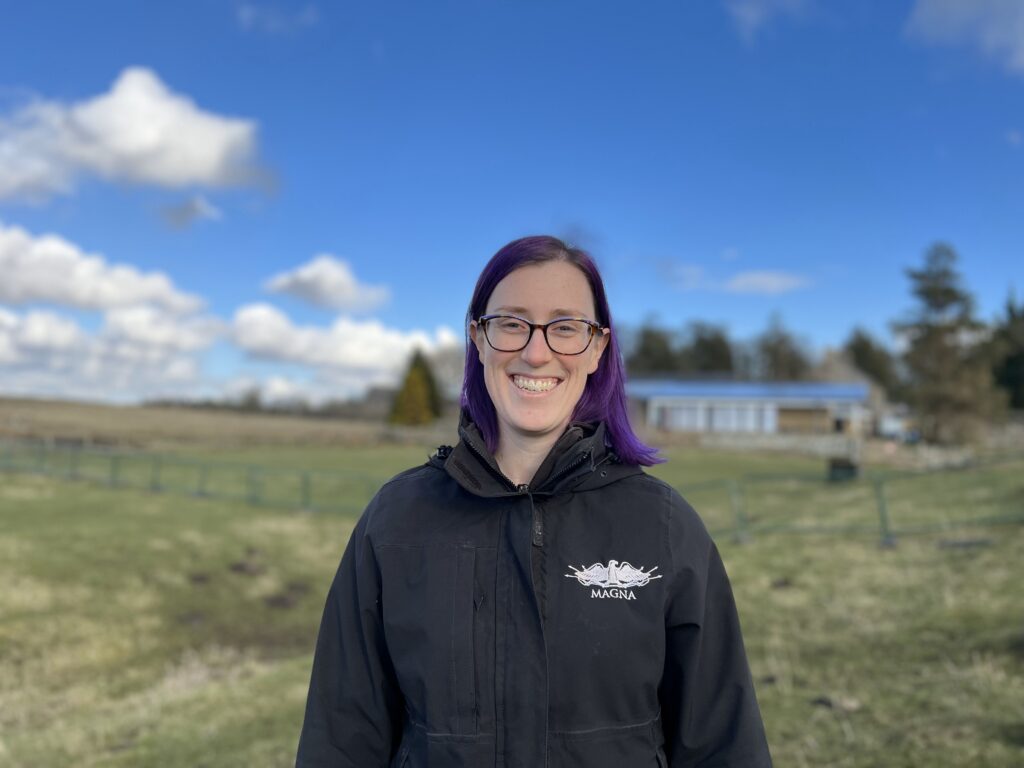Magna Dig Diary 2025
64 minutes reading time.
Magna 2025 excavations have now finished. Click here to find out how you can get involved in 2026.
Here in this Dig Diary we will post regular updates on the current excavations and post excavation taking place on site. You will hear from our archaeologists and volunteers as they share news and thoughts about what is being uncovered, the challenges and the highlights of the excavation season.
If you’d like to catch up on what was uncovered in Year 1 & 2 of the Magna Project you can read our 2023 Dig Diary, 2024 Dig Diary, and check out updates on our YouTube channel.
Who you’ll hear from (guest volunteers will sign off with their first name and “volunteer”):
Rachel: Senior Archaeologist for the Magna Project
Franki: Geoarchaeologist for the Magna Project
Sophie: Activity & Diversity Officer for the Magna Project
Cristina: Vindolanda Trust Pottery Specialist
Sonya: Vindolanda Trust Communications Manager
Rebecca: Archaeology Assistant for the Magna Project
Want to check on a specific period? Use the links below to take you to the start of each period of excavations. The latest posts are at the top of the page.
Period 1: 14th – 25th April 2025
Period 2: 28th April – 9th May 2025
Period 3: 12th May – 23rd May 2025
Period 4: 26th May – 6th June 2025
Period 5: 9th June – 20th June 2025
Period 6: 23rd June – 4th July 2025
Period 7: 7th – 18th July 2025
Period 8: 21st July – 1st August 2025
Period 9: 4th August – 15th August 2025
Period 10: 18th August – 29th August 2025
Period 11: 1st – 12th September 2025
Period 12: 15th – 26th September 2025
19th November
While is every day onsite is exciting, with constant new discoveries about the history of Magna fort, there are some moments that stick in your memory more than others. Sometimes it’s because we’ve faced some extreme weather or flooding in the trenches, but on other occasions it can be due to a particularly special find.
One such day came in early August this year, when our volunteer Shaun called me over saying he had something I needed to come and see. Heading over to where he was digging, I was amazed when he showed me a complete silver finger ring with an intaglio set into it. Even before any cleaning or conservation it was obvious that this was a beautiful piece of jewellery, and in really good condition despite being buried for over 1500 years! A simple design was visible on the front of the band and after a bit of examination a tiny hare was visible carved into the (probably) carnelian intaglio.
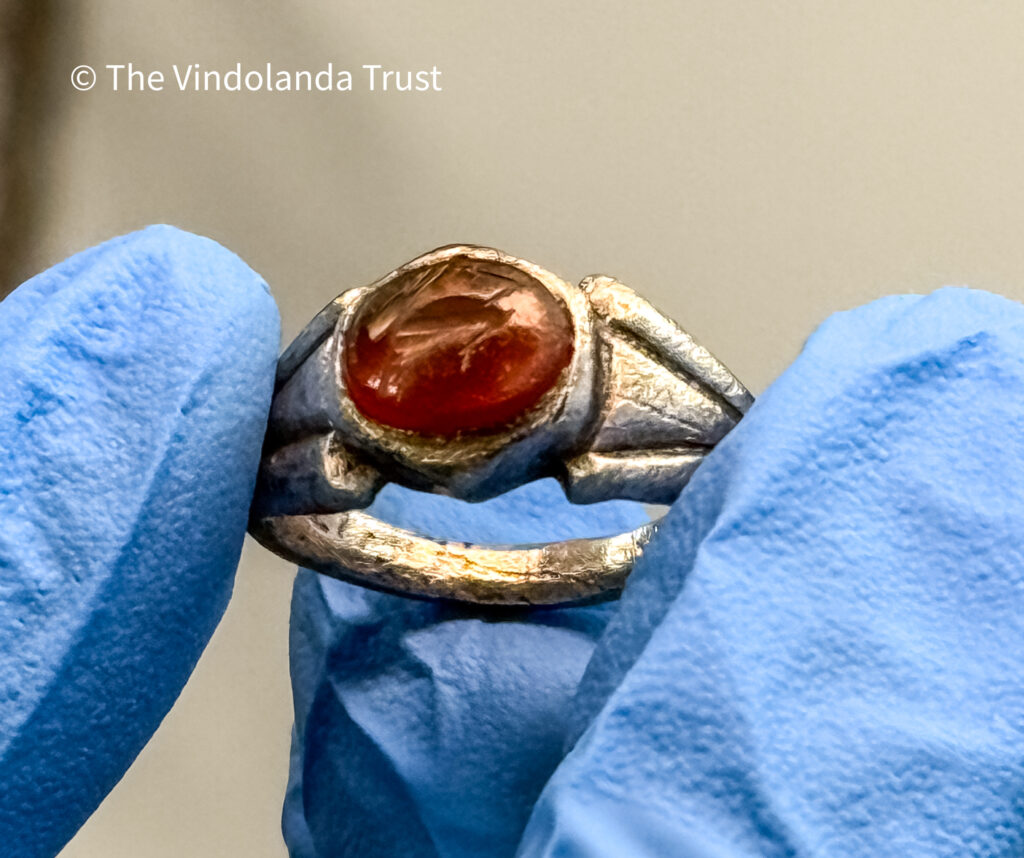
Although excavating the rest of the deposit this ring was found in provided no clues about its story, I can’t help wondering about its owner and how it came to be there. Was it worn by a man or a woman? Who were they and why were they at Magna? Did they lose the ring, and how did they react when they realised? We might never know the answer to these questions, but we can at least appreciate the beauty and craftsmanship of this artefact now it has been brought to light once again. Rachel
The ring is featured in episode 3 of Sandi Toksvig’s Hidden Wonders programme. We had a great week with Sandi and Raksha Dave back in August. You can watch the series on demand on Channel 4.
26th September
And just like that, we’ve come to the end of our 2025 season!
It’s been a wonderful twelve periods with 200 volunteers who have joined us in the trenches and on our post-excavation team. Thank you to everyone who has helped us dig, processed the finds, visited us trench side, and kept up to date with this Dig Diary.
If you are already thinking about returning next year, or have been inspired to excavate with us, make sure to check out all the information about the 2026 excavation here. Sophie
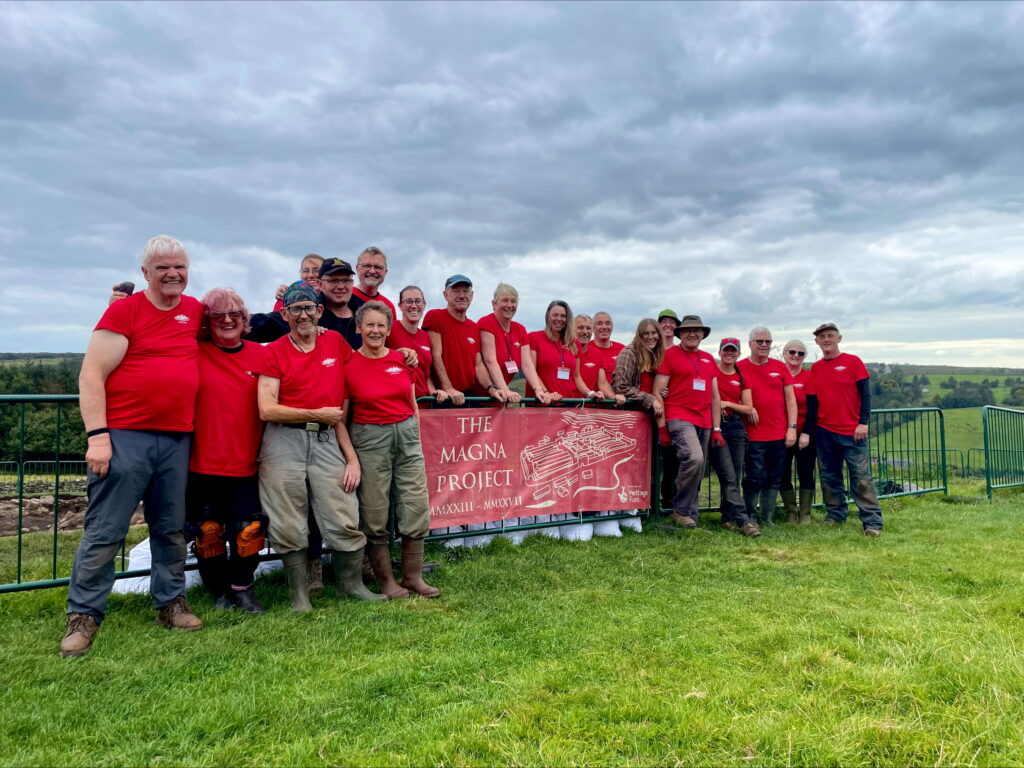
18th September
One of the best parts of working on the Magna Excavations is being able to share the dig with colleagues from across the Vindolanda Trust. Shay, one of our amazing customer service team members, joined us in the trenches for a few days last period to see what life is like on site. Here’s what he had to say about his first ever excavation experience. Sophie
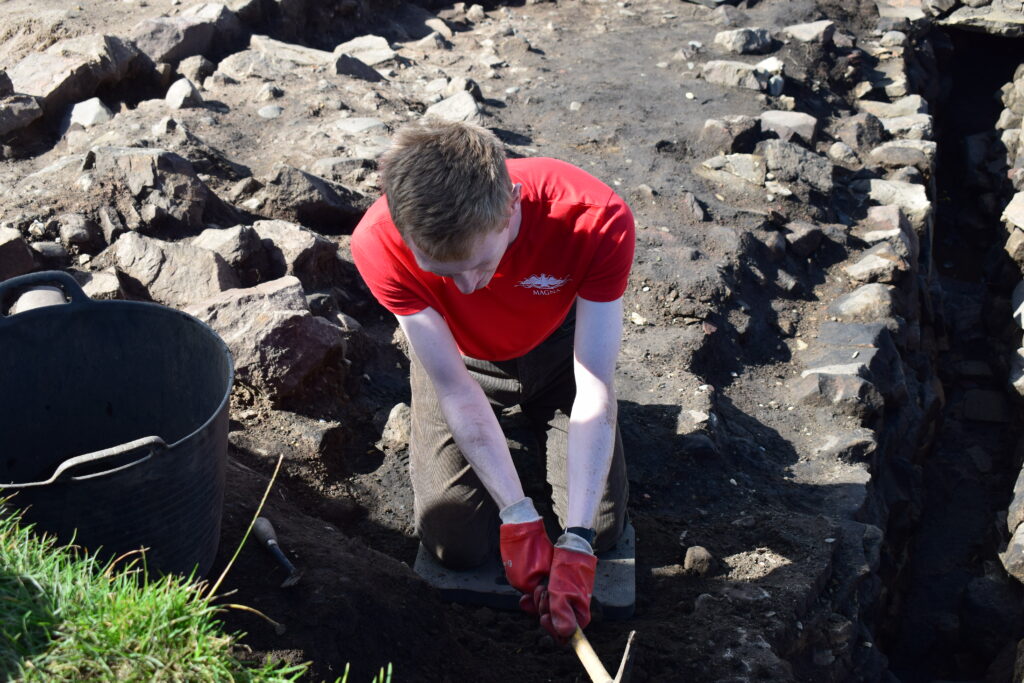
After visiting the site at Magna one day I was enthusiastically given a tour of the drains and mysteries of the fort by one of our archaeologists.
So, I thought I must give it a try, and it was so much fun! Digging up the mysteries of a corner that has been giving more questions than answers was truly fascinating. Finding so many animal bones and bits of pottery at the far end of a drain created so many stories in my head of what had happened thousands of years ago. It was so nice too working around people who were just as fascinated and curious as I am about the forgotten world under our feet, working in a team with them has made me appreciate and understand the part of the world I live in even more!
I’m so excited for next year’s season so more people can unearth what Magna has to say about Roman life. Shay
16th September
As we welcome our final cohort of 2025 excavation volunteers to Magna, one of our Period 11 Volunteers, Roy, reflects on his time in the trenches… Sophie
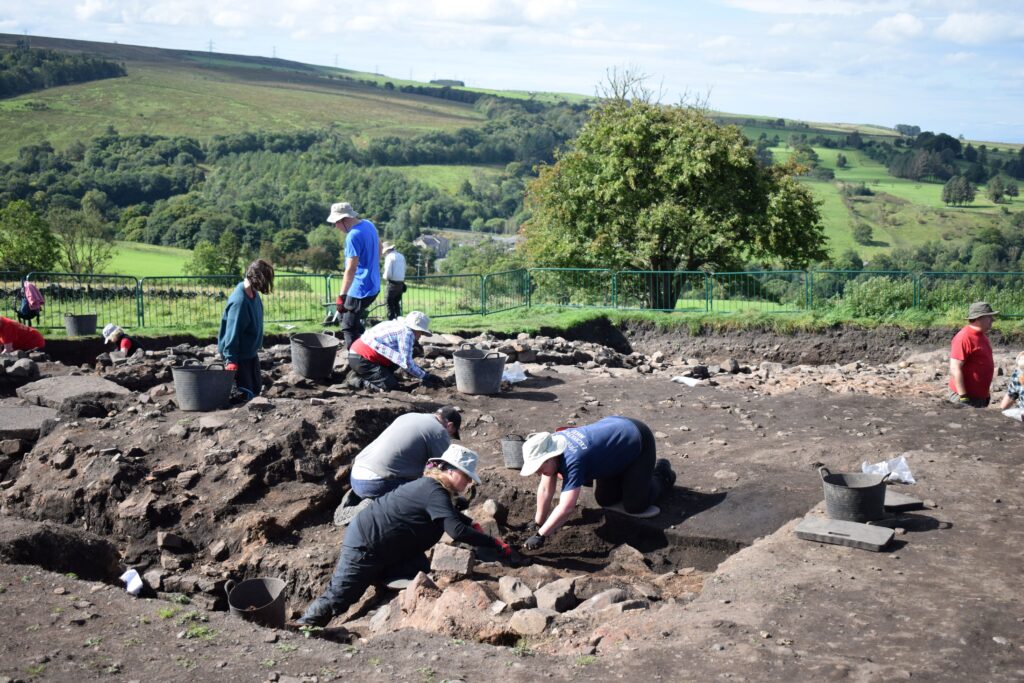
From Einstein’s theories one of the causes of time dilation is the difference in elapsed time as measured by two clocks because of a relative velocity between them (theory of special relativity).
So the period 11 team must have been digging so fast that there was a warp in spacetime – this could explain why, for the general public two weeks had passed, whereas for the period 11 diggers it appeared that only 5 minutes had passed between commanding office Rachel assigning us to our positions on the morning of Monday 1st September and us needing to abandon ship due to the rain, hail and wind on the afternoon of Friday 12th September.
Following orders on the first Monday, Jude and myself were consigned to the upper reaches of the magnificent drains. Amongst my finds in the drains were cow bones, a few bits of pottery and a pig’s tooth. We lost the first Wednesday to rain – the officers arranged for the Magna team to have a guide around the dig in progress at Vindolanda led by Andrew Birley and the Vindolanda team had a reciprocal visit to Magna.
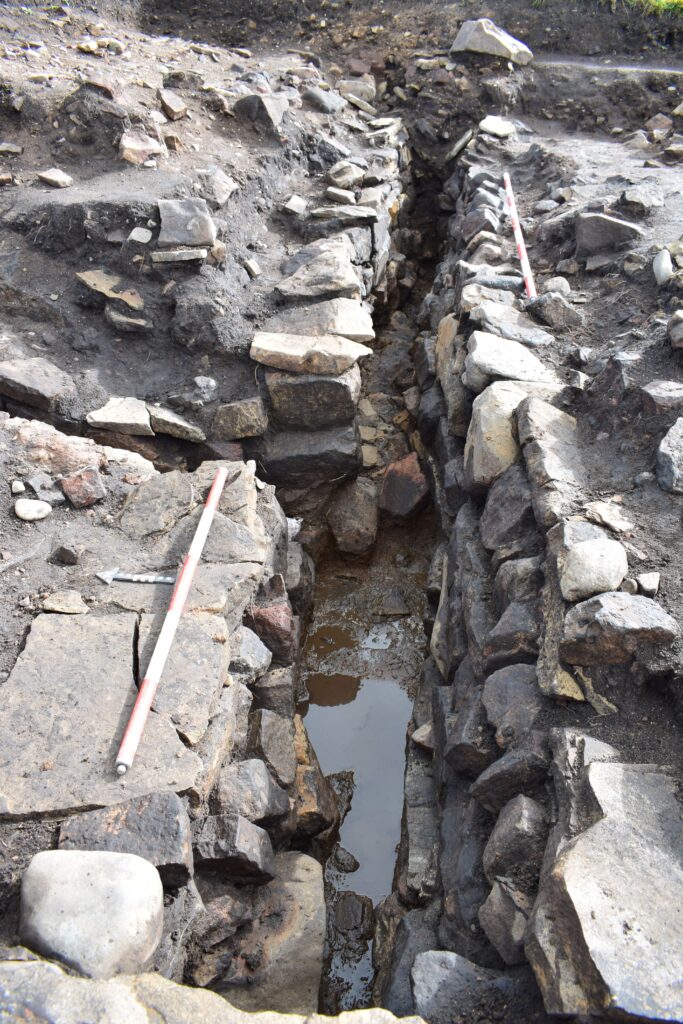
Weather improved again from Thursday onwards. I escaped from the drain to attempt to uncover the internal fort road to the south of the praetorium. There was previously uncovered road surface to the west and to the east, my mission was to gently go through the dark topsoil to find the sandy layer underneath. The last time I had so much excitement on finding sand must have been with a bucket and spade at the seaside – there as predicted by commanding officer Rachel was the sandy layer. Two pieces of painted pottery were the initial small finds in my new area, apart from that there were several lumps of metal processing slag.
Chris in front of me was gradually converging on the same area leading us to have a discussion on the demarcation line between our spheres of influence i.e. which of us had the rights to define which cobbles. To the right of me Fran was beating me in finding 5 sherds of pottery to my zero, I pulled it back to 5-2 on the Thursday before the rain interrupted play.
Glenn on the other side of the praetorium wall, i.e. on the inside of the building, had the excitement of finding a bead. But rather than being nearly 2,000 years old it turned out to be maybe 3 years old – it was a toggle that had fallen off his 21st century waterproof jacket and been covered in mud.
Before we had to abandon digging around lunchtime on Friday Phil had uncovered a fragile dog’s skull. As this was in the praetorium could this have been a Roman commanding officer’s favourite hunting dog? The period 12 team now just need to find the dog-collar tag with the owner’s name.
All this with excellent supervision from Rachel, Franki and Rebecca plus a really good meal out in a local restaurant with my fellow volunteers made for an excellent fortnight. Roy Volunteer
12th September
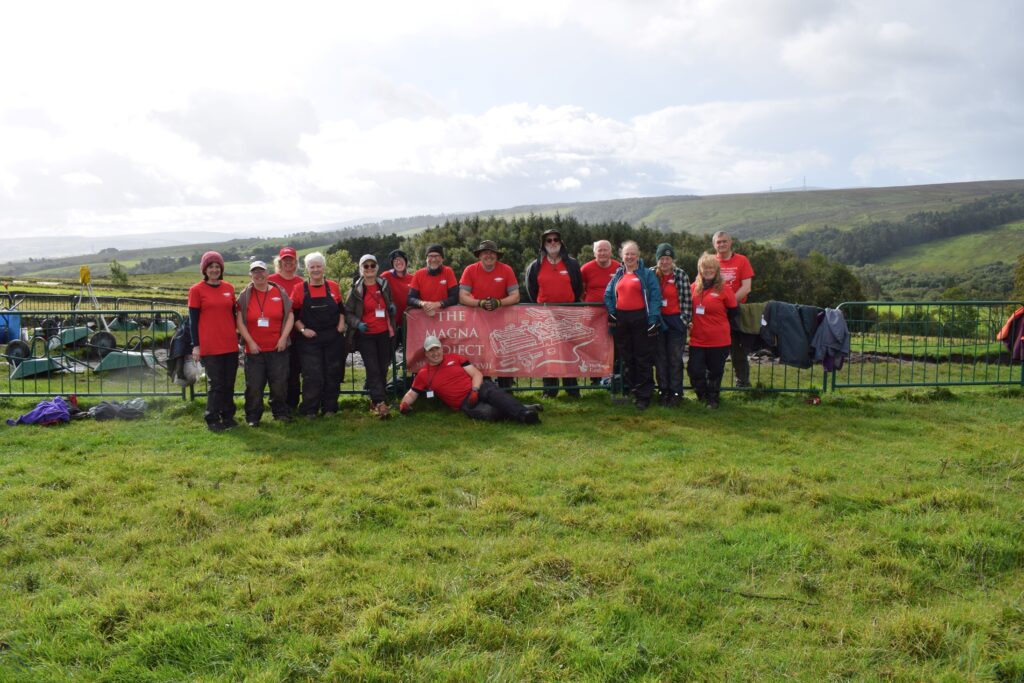
Yesterday the Vindolanda Trust held our annual Friends Day gathering, and in time honoured tradition the weather decided to give us four seasons in one day! Despite this, it was lovely to see so many familiar faces coming down to the excavations to say hello and see what we’ve been happening at Magna this year. This included lots of volunteers from earlier in the season, keen to check in on their areas of the site and see how they’ve turned out.
While much of our efforts this season have focussed on revealing the remains of the 4th century stone fort and antiquarian excavations, we have in the process started to see glimpses of an earlier stone fort poking through. Most of this has been at the west edge of the trench where we have two possible rampart ovens (the first of which was mentioned in a previous dig diary) and short section of stone wall which may be the outer fort wall of larger fort. The presence of these structures below the later archaeology is a really promising sign for the survival of the earlier forts at Magna, meaning we will hopefully be able to reconstruct the sequence of occupation at the site as we dig deeper in future seasons! Rachel
9th September
Somehow there is only three weeks left of the excavation season! This summer seems to have flown by, but we accomplished lots in that time. Part of these final three weeks is preparing for next summer, and we are partially doing so by beginning to take topsoil pXRF samples to the north of our current trench, in the area we plan to deturf next year. These samples will allow for a geochemical analysis of the soil which could potentially reveal different rooms/buildings within the fort. This is especially exciting given that we are potentially on top of the praetorium next year – hopefully these samples will give us hints about where we’re digging into before we even break ground.

On the excavation side of things, we’re continuing to dig through the Georgian rubble to find Roman remains underneath. It’s still too early to confidently state what these remains are, but it appears to be a structure potentially related to the praetorium bath suite. It would be very exciting if the antiquarians didn’t fully ‘remove’ the building! However, I fear that we might not have the answers to these questions until next year – our volunteers are hardy, but it is still difficult to remove over 50cm depth of Georgian rubble backfill from a quarter of our trench area.
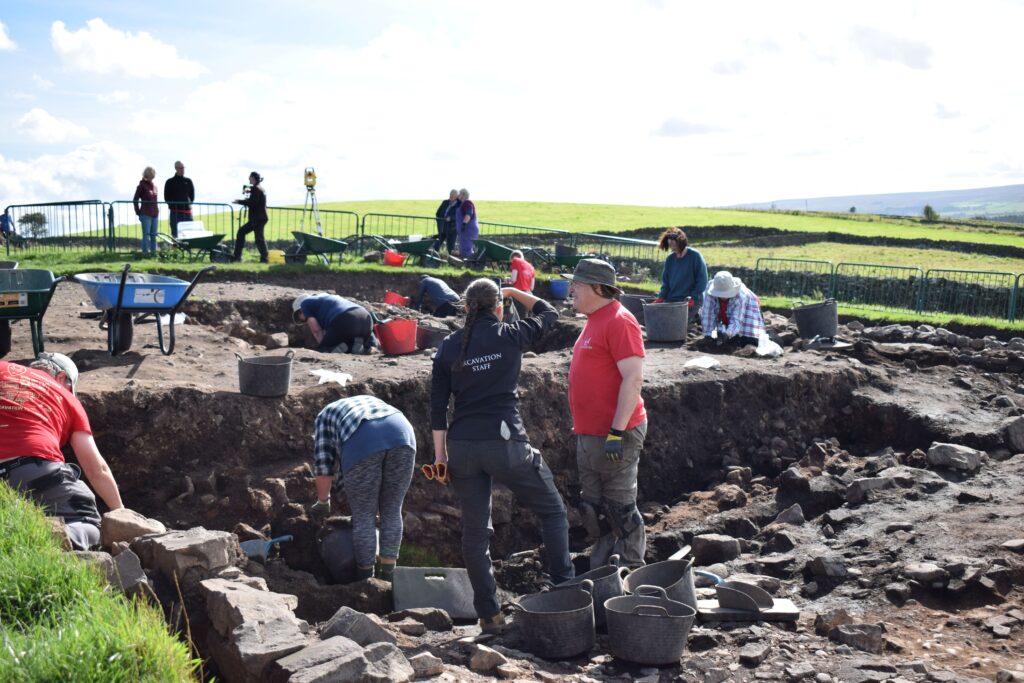
We’ve also managed to find more of the southern fort wall which we previously believed to be robbed. The fort wall dipped down considerably in this area which is why it was initially hard to find. Nevertheless, we now have a few additional courses of the southern wall to help add to our collection.
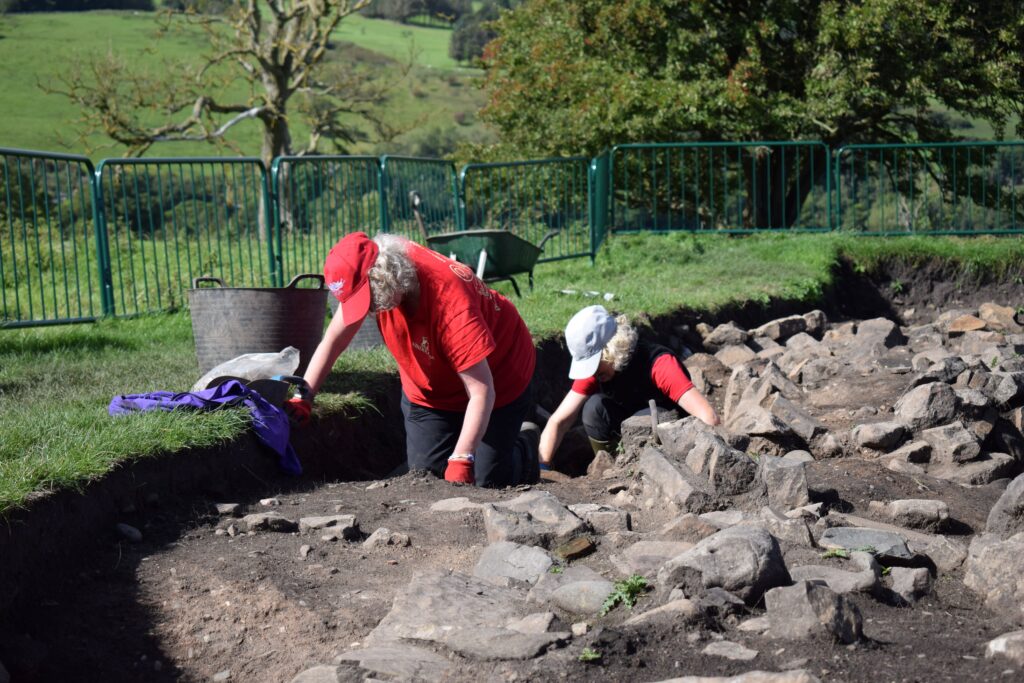
Hopefully we’ll continue to reveal more about the 4th century fort in this second week with our Period 11 volunteers and in the final two weeks with the Period 12 volunteers. Franki
28th August
As the excavation progresses, we are tackling not only the interior of the most recent stone fort, but also the area immediately in front of it. Interestingly, we are discovering a few features that are unusual in this context. These include two oven structures. The oven pictured is located outside the last stone fort wall to the west. Similar oven structures often appear along the ramparts of forts. These are earth mounds stretching along the inner perimeter of fort walls, forming part of the defensive system together with the ditches and the wall. As well as having a defensive function, the rampart is also a communal area (e.g. latrine blocks).
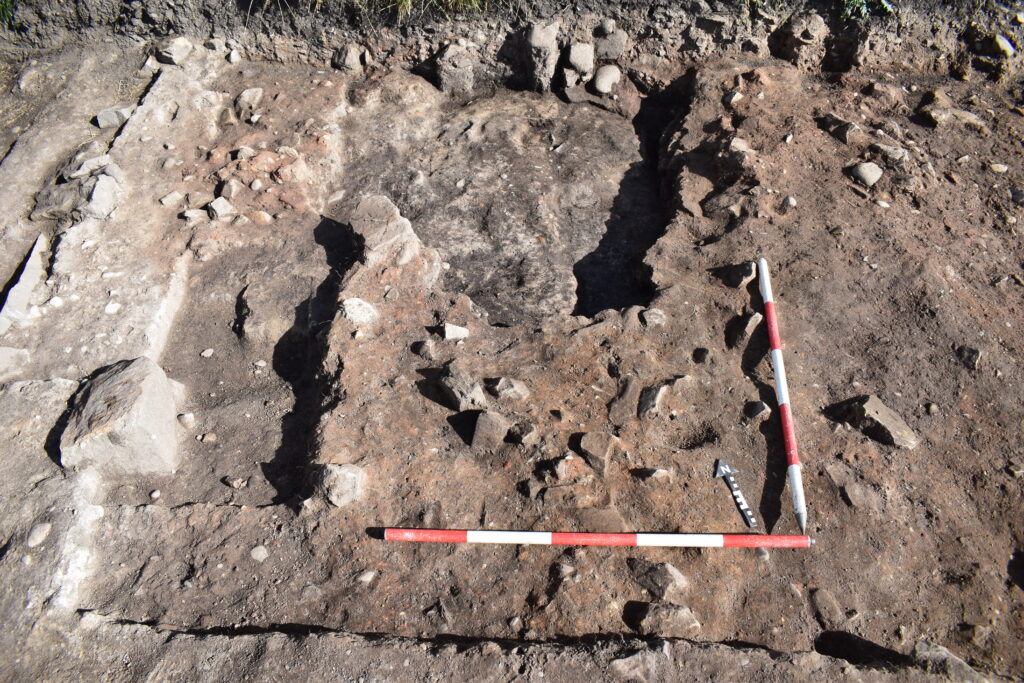
Based on its location in relation to the last stone fort wall, one might question whether this structure was located inside an earlier fort wall, and indeed a rampart oven. These features had various purposes, ranging from baking to metalwork and even recycling materials. However, the preservation is rather poor, and any stonework was likely truncated when a clay bank was placed outside the late fort wall. Rebecca
We’ve also uncovered a smaller hearth along the outer corner of the fort wall. This hearth still had some of its stone structure remaining and contained lots of clinker and iron inclusions. The nature of the fill thus suggests that this hearth was used for metalworking rather than cooking. This feature has been thoroughly sampled for environmental data, and hopefully these samples will allow us to discern further details into exactly what kind of metalworking was taking place in this hearth. These types of features allow a glimpse into other aspects of Roman life at the fort, beyond the standard military duties of soldiers stationed there. Franki
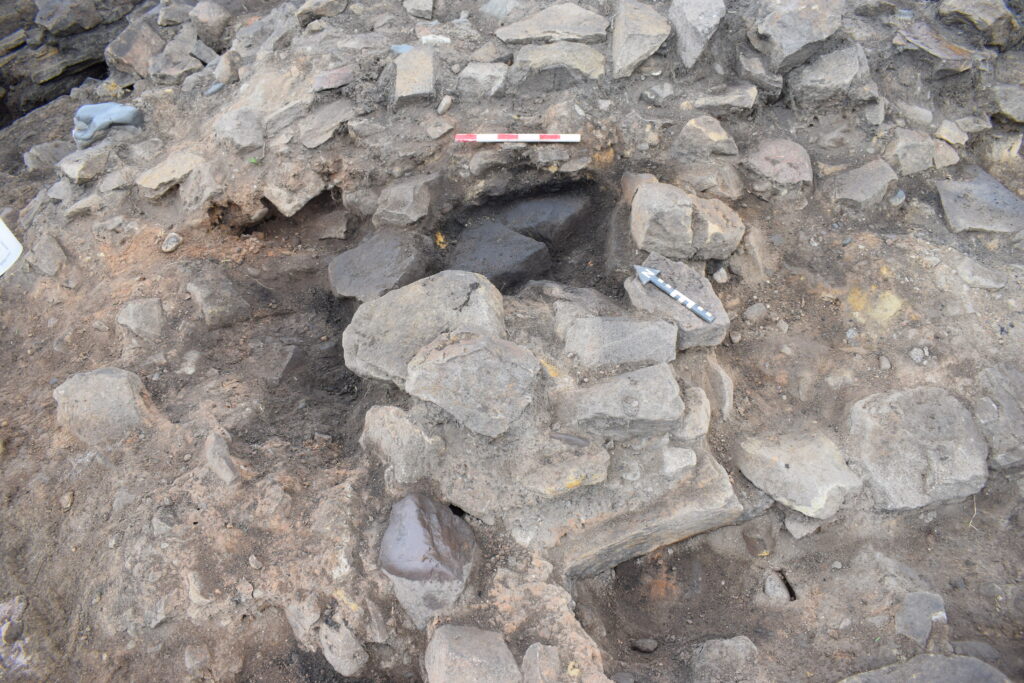
20th August
The excavations got off to a strong start this morning with our first small find of the day appearing in the first half an hour of the day.
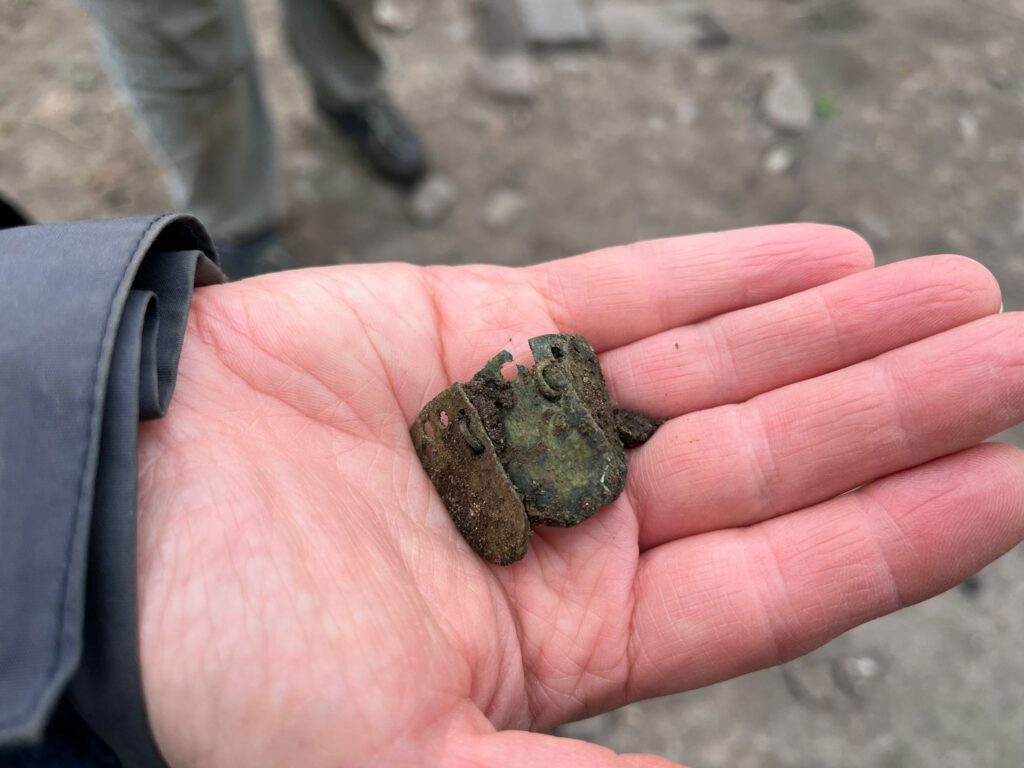
These three scales of copper alloy lorica squamata, or scale armour, still have two of the original links holding them together. This shows how the small holes pierced through each scale were used to join the scales both to each other and to an underlayer in overlapping layers to form the final armour. Although green with corrosion now the scales would have originally gleamed a bright golden colour, giving the soldier who wore this a striking appearance, especially if it was a sunny day! Rachel
18th August
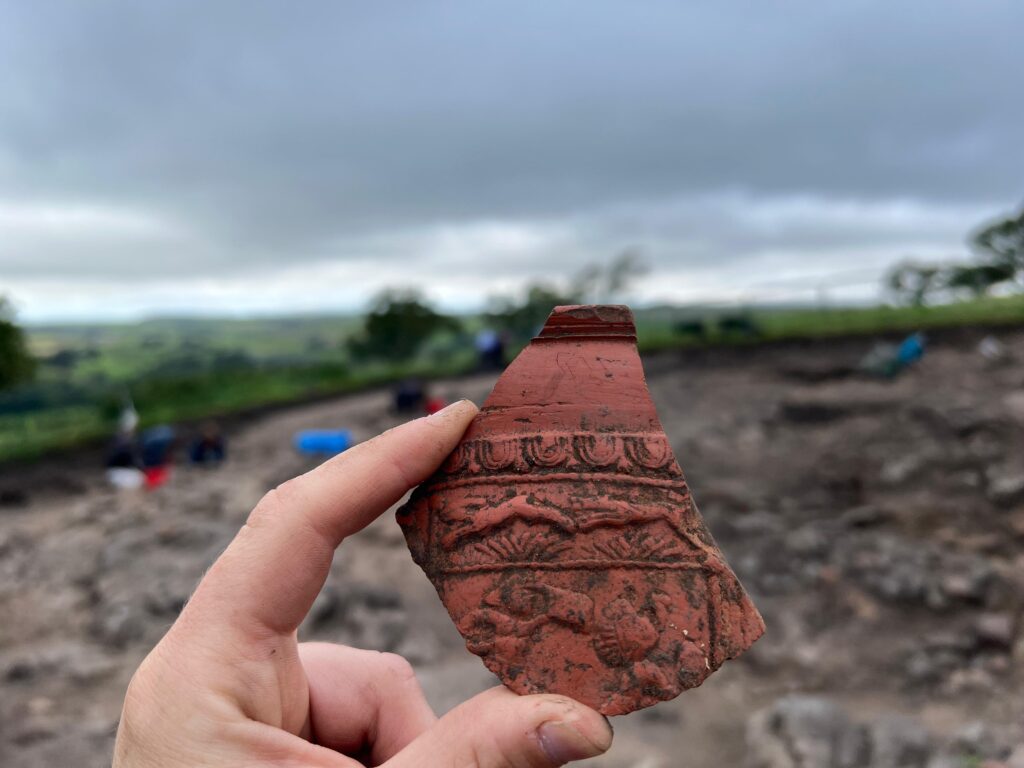
It’s been a busy few weeks here at Magna, as the team have cracked on with uncovering the remains of the last stone fort. Alongside all the structural remains, we are also getting more frequent finds from the site such as animal bone, pottery, and building material.
This has included a large sherd of decorated Samian pottery with a border of running animals and the top half of two figures below, which appear to be part of a gladiator combat scene. Once it has all been cleaned up our pottery specialist will be able to take a closer look and see what else we can work out about this vessel.
In amongst all the fragments or brick and tile, one particular piece bore a poignant connection to the past in the form of three fingerprints visible in its surface, providing a very direct connection with the person who made this tile nearly two thousand years ago.
The majority of the animal bone we find is waste from the meals the inhabitants of the fort were cooking and eating every day, but every so often we find bone that has been turned into objects. One such example is a small bone needle discovered recently, intact but with a hairline fracture running down the length. This may have been enough damage for it to be thrown away, or it might have been lost out of the owner’s sewing kit.
Finding all of these different types of objects makes sense because we are now excavating in one of the most intensively occupied areas of the site, and they provide a little snapshot of what daily life would have looked like for the people living and working at Magna in the late Roman period. I can’t wait to see what new insights await us during the final six weeks of the 2025 season. Rachel
15th August
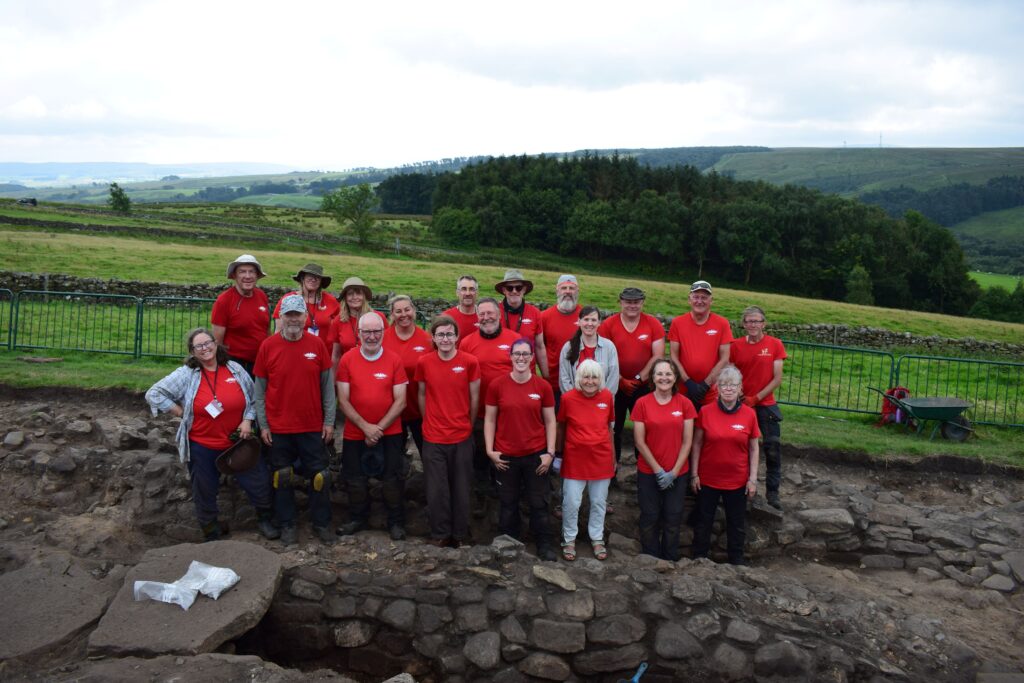
After a hot – but rewarding – couple of weeks, we wave good bye to our wonderful Period 9 crew! They’ve done an amazing job and we are looking forward to welcoming our Period 10 Team on Monday! Sophie
7th August
Throughout the excavation season, we take a wide variety of environmental samples to add to our understanding of daily Roman life and the historic landscape. One type of sample aims to uncover fossil pollen remains which lets us know what plants were growing in the area when the soil was exposed to the air. In our current trench, we haven’t reached suitable soil for pollen sampling yet, although I’m sure that’s coming in next year’s excavations. This is because similar to our organic finds, pollen is best preserved in anaerobic environments which significantly slows the process of decomposition. Earlier this year, we took pollen samples from our two defensive ditches to the north of the fort. We took these samples using kubiena tins (think extra long loaf tins) which prevent the pollen from being damaged during sampling. These tins have to be hammered into the section of the ditch which can be quite difficult work! Luckily we had some strong volunteers to help us get the tins flush with the section. After the tins are in the section, we label the top and bottom to ensure that nothing gets mixed up (as I often say to our post-ex volunteers when they help process our environmental samples, it is difficult to determine where the soil has come from if it loses its label – so labelling is one of the most important parts of soil sampling!). After the tins are removed, they are wrapped in cling film and masking tape to ensure that the fossil pollen remains will not dry out. If the pollen dries out, they will fracture which makes species identification difficult.
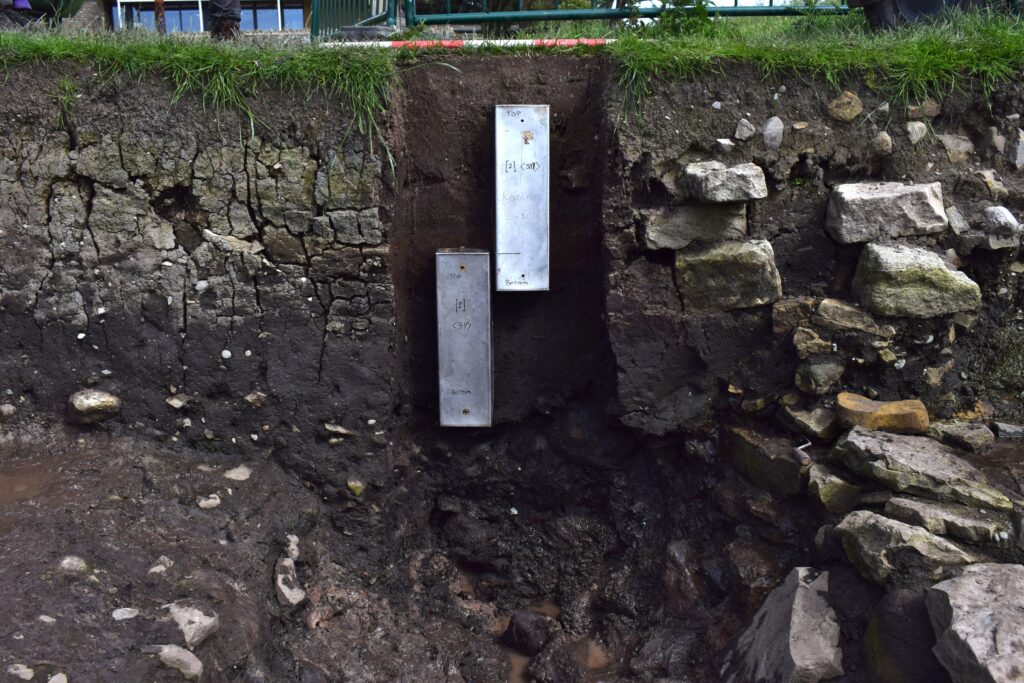
These tins will go up to a colleague in Scotland who specializes in paleoecology. His report on the pollen samples from the 2024 excavation season can be found in our 2024 interim report. Hopefully, these samples will tell us what was growing around Magna fort! Based on what we uncovered in the peat surrounding our ditch system, I bet silver birch will be at least one of the species on that list. With luck we’ll also find a variety of agricultural pollen remains to give hints at what the Romans planted themselves. These pollen samples, along with the wide variety of other environmental sampling methods we use on site, all help form a greater picture of Roman Magna. Franki
5th August
One month in and the team are making excellent progress in the southwest quadrant of the fort, with more and more of the stone fort becoming visible every day. Work continues on defining the south wall of the fort, cleaning along the outer face at the south trench edge, however uncovering the west wall has been more challenging. Here we have found significantly more damaged remains with only a few foundation stone of the outer face left in situ, much like we saw with the north wall earlier in the season. Whether this is due to stone robbing, a collapse of the wall down the adjacent slope or a bit of both remains to be seen.
Inside the walls the backfilled antiquarian trench is still dominating the trench as we try to define the extent of the disturbed deposits. However, sections of intact Roman archaeology are starting to appear as we excavated deeper including the intervallum road which comes down the inside face of the west wall before curving in towards the centre of the trench and a potential wall (or yet another drain depending who you ask!) close to the north trench edge. We will have to wait until we expand our trench to the north to get a final verdict on this though, a good reminder that patience is a key skill for an archaeologist! Rachel
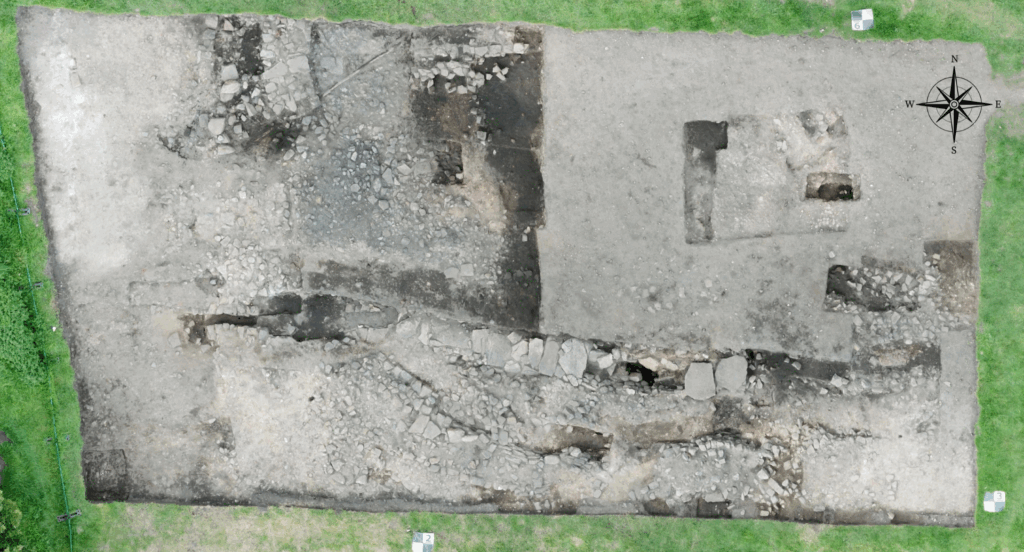
1st August
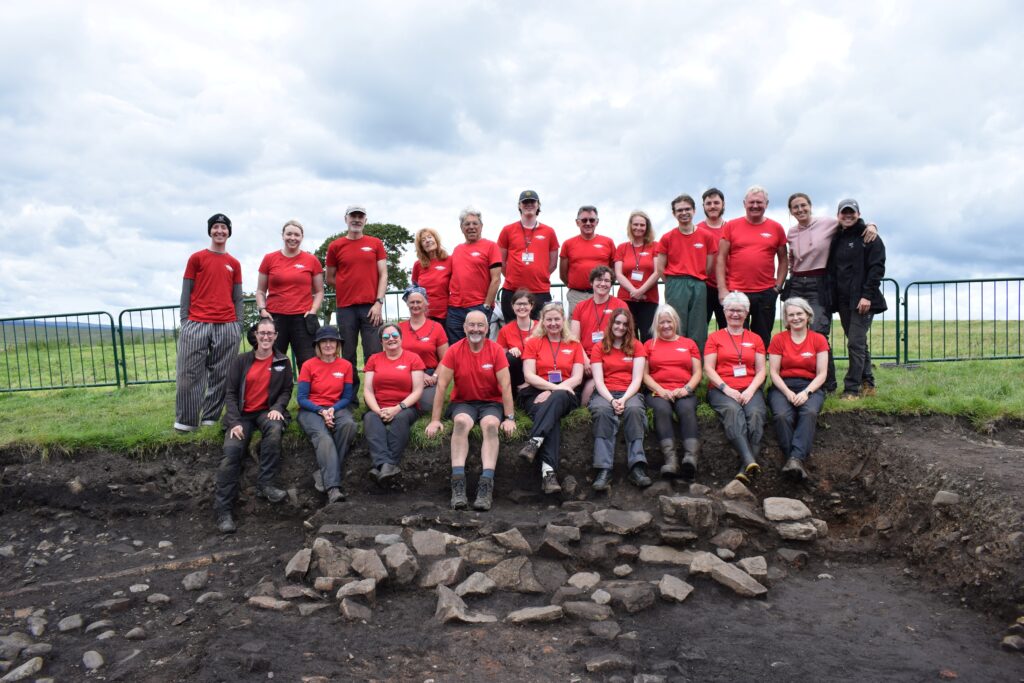
Well done to our Period 8 team for their hard work in the south-west corner of the Fort over the past two weeks! The team have moved a lot of dirt and uncovered some exciting archaeological finds along the way. Period 8 volunteer, Pippa, shares a summary of her experience at Magna. Sophie
After a well-earned sticky toffee pudding at Twice Brewed, I’m reflecting on my time digging at Magna. After several very enjoyable stints at Vindolanda, I was nervous about somewhere new. How could anything compare to the magical location of Vindolanda? I need not have worried, day by day Magna is becoming familiar. Looking out to the Solway Firth I’ve watched mist rolling towards us and sunshine clear it away again. To the north, walkers traverse Hadrian’s Wall. To the south, the Pennines drift in and out of view as the clouds roll by whilst the farmer cuts the hay. Meanwhile the fort is revealing itself, tantalising glimpses of life nearly 2,000 years ago. My trowel is helping to uncover walls, paths and drains, many drains. Although I would love to be teasing apart anaerobic lumps for leather and textiles, I have fallen for Magna’s charms. Pippa Volunteer
31st July
As Period 8 of the 2025 excavation season draws to a close, Magna volunteer Tony shares his insights and experiences from the trenches, where he’s been helping uncover the Inter-Vallum Road. Sophie
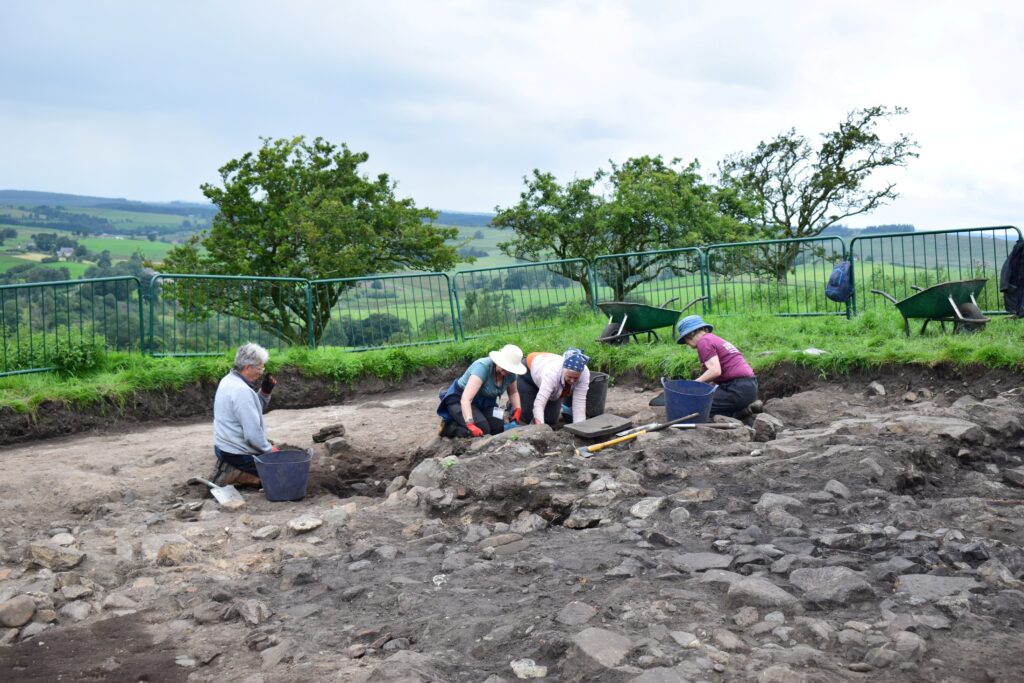
As a relative newbie – I did excavate at Vindolanda in 2018 – my week one challenge, in conjunction with Mark and Tina, later reinforced by Sue, was to unearth the inter-vallum road: the road that runs around the fort, immediately inside of the walls.
The Magna inter-vallum proved to be a mixed bag: large stones interspersed with small pebbles. The surface is uneven and nowhere near as flat as the empire-linking, beautifully paved roads that are famous throughout the Empire.
The nature of the surface presents its challenges: a good half hour of vigorous, relatively fast clearance trowelling between the larger stones, can then be followed by a very slow hour of delicate trowelling and gentle brushing, as the focus shifts to inching forward without disturbing too much of the pebble surface. It can make for long days that test one’s patience!
But the archaeological rewards are still there for the persistent volunteer.
In amongst the rocks, pebbles and black loamy soil (which would be a welcome addition to any veggie patch), there have been many animal bones, numerous pottery shards (including one small but exquisite piece of Samian ware, featuring a lion’s feet) and one Roman nail.
Two items of some intrigue also emerged in week one. The first was a large, flat and smooth rectangular stone, at the bottom of the current level, which looks suspiciously like the top of a drain. Of potentially even greater interest is what could prove to be a personal altar, which at this stage remains in situ between layers, waiting to be fully revealed in the weeks to come. Tony Volunteer
30th July
The mysteries of Magna fort continue to be revealed as we excavate further in the southwestern corner. We have more wall remaining than we initially thought, however the remaining courses are curving in a snake-like fashion, likely due the instability of the ground beneath. Nevertheless, we are excited to see a few standing courses from the 4th century fort still intact. Even more exciting is the large stone drain sitting just inside the fort wall. The large size of this drain indicates that a toilet block might be nearby! Regardless, a few capstones remain over this drain which bodes well for finding ancient seeds or parasite eggs within the soil. These ecofacts will help us learn about the diet and living environment of the Romans at Magna, giving us a more cohesive understanding of life at the fort. When a similar drain was found at Vindolanda, they were able to shed light upon the health of those living at the fort on account of discovering roundworm and whipworm eggs in the soil. More information on parasites uncovered at Vindolanda can be found here https://www.vindolanda.com/blog/ancient-parasites.
In the finds department, we are already getting a thrilling variety of material remains. Highlights are an arrowhead, candlestick, and complete bone hairpin – all of which are firsts for Magna! These finds promise much more excitement as we dig deeper, especially given that we’re just barely touching the 4th century remains. Franki
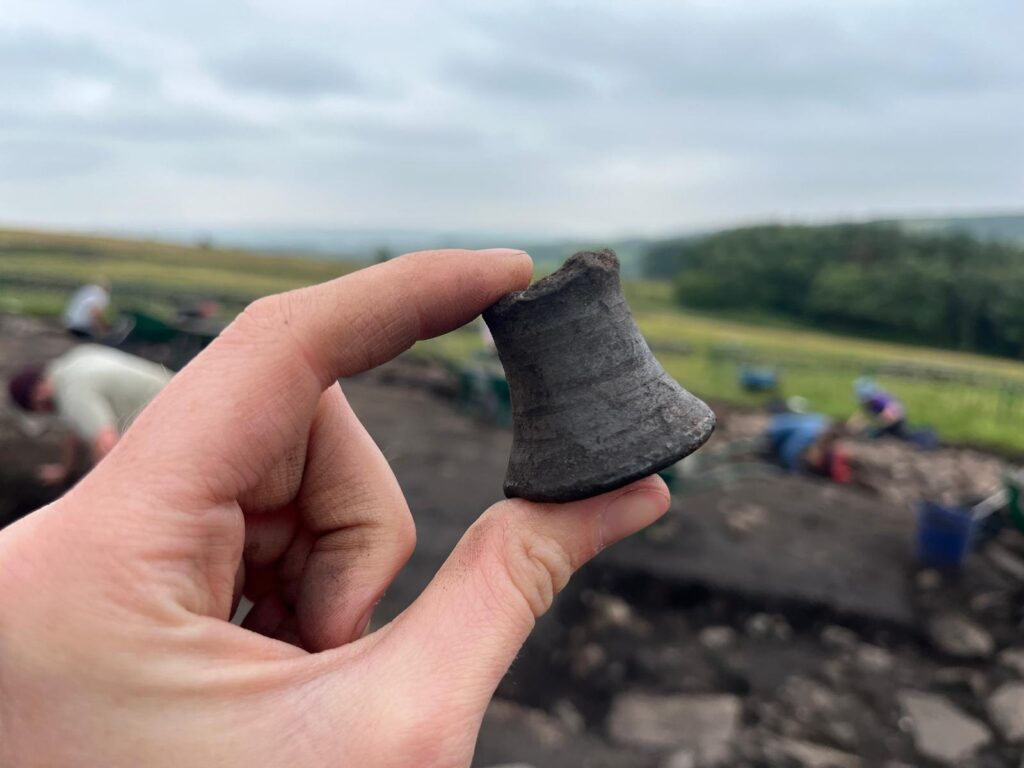
Introducing Rebecca Nashan, Archaeology Assistant
We are delighted to be joined on site by our Archaeology Assistant, Rebecca Nashan. Rebecca joined the Vindolanda Trust as the archaeological assistant in April and supports the excavation teams at Vindolanda and Magna. She spent the first three months excavating at Vindolanda and transferred to Magna at the beginning of July.
Apart from her work, she recently finished her PhD at Newcastle University in collaboration with the state heritage department in Germany. Besides living and working on the northern frontier of the Roman Empire, she is particularly interested in the Rhine frontier. Her research focuses on late antique funerary practices and material culture, and she is passionate about creating archaeological illustrations, as well as finds and site photography. Rebecca is part of the Roman Frontiers ECR network team and is always on the lookout for opportunities for interdisciplinary research. Rebecca
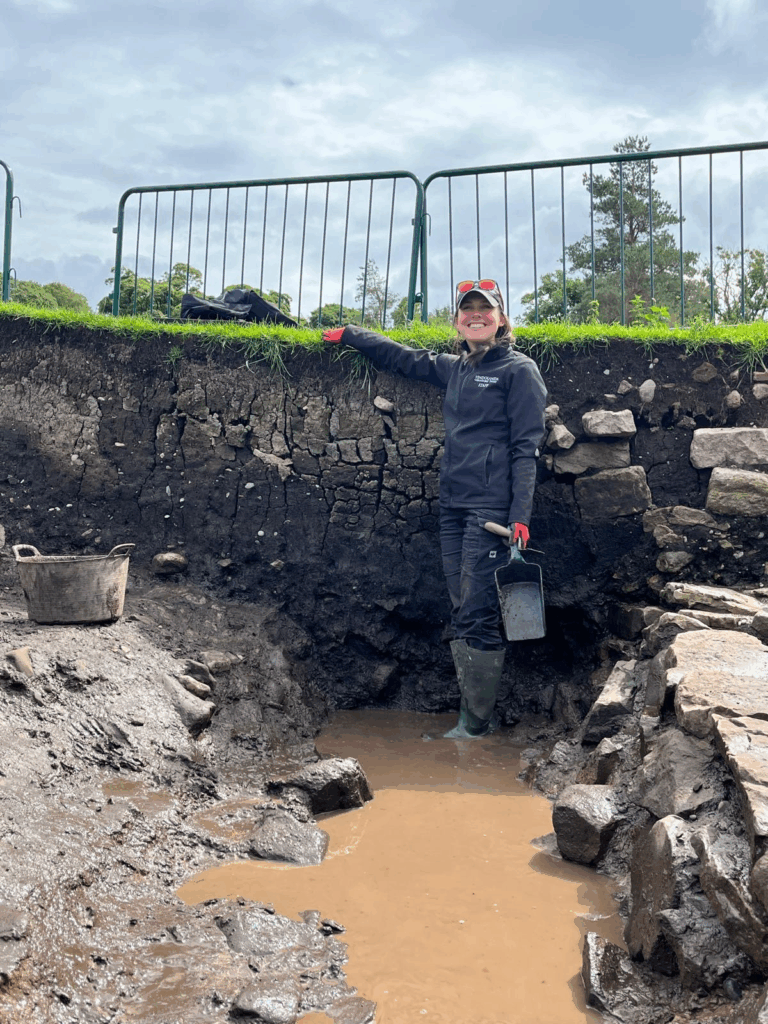
18th July
The southwestern fort trench is off to a great start! Our volunteers this period managed to conquer the imposing task of removing heaps of topsoil to uncover the foundations of the most recent stone fort which just manages to fit within our current limits of excavation. Finding these foundations gives us a better idea of the size of Magna fort at the point of its last occupation. Because we have excavated the foundations for both the northern and southern walls, we can now archaeologically confirm that the fort is more of a square shape rather than the typical playing card shape. As the excavations continue, we’ll hope to discover why this decision was made. Franki
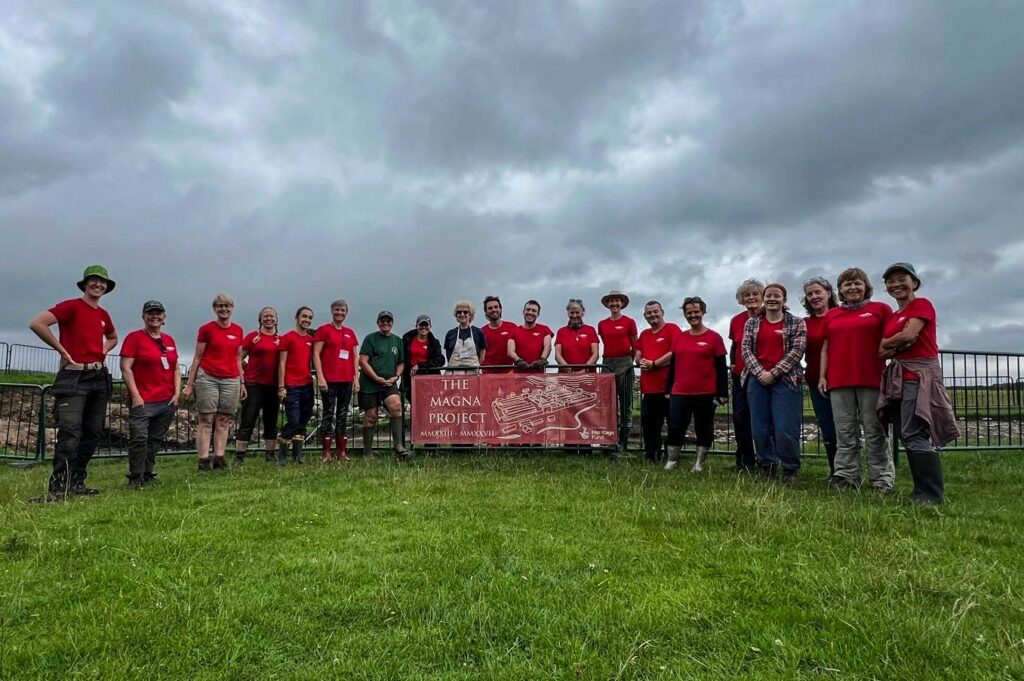
14th July
Excavations inside the walls of Magna’s last Roman fort have now officially begun! This past week, we have started de-turfing the southwestern corner of the fort plateau, for the first time since its antiquarian exploration in 1830! We’ll be digging in this area for the remainder of the project, so it’s exciting to get a head start.
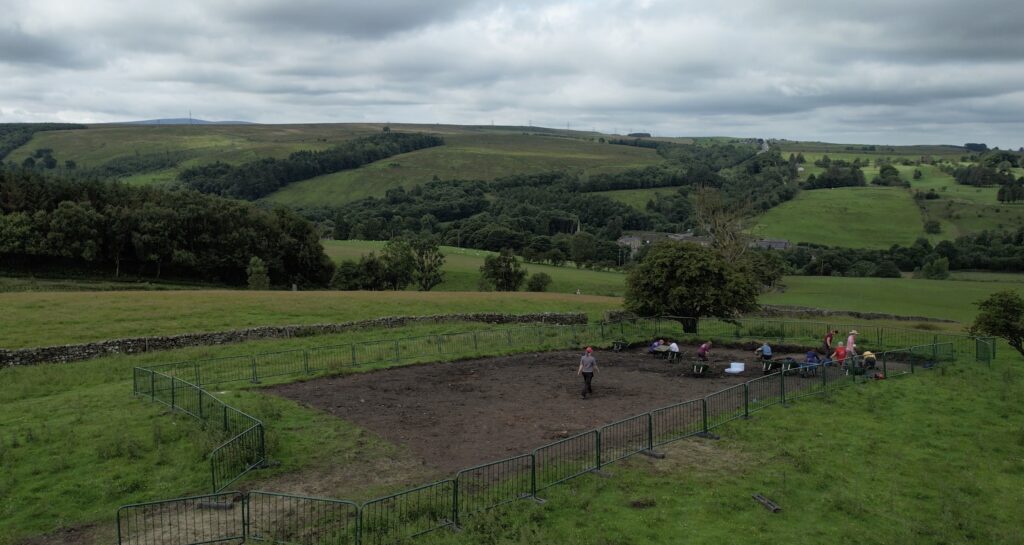
The first step in our investigation is to establish the extent to which this area was disturbed by both farming activities and antiquarian investigation. As Robin Birley reports in his book, The Fort at the Rock, the 1830’s excavations uncovered a well-constructed bath suite. Sources say that the bath suite had beautifully painted plaster walls and even an altar to the goddess Fortuna within. But the farmer was displeased by the continual disturbance to his land and crops by tourists hoping to view the archaeology and, as a result, he had the remains ‘removed’ after only a few years. Luckily, antiquarian John Hodgson wrote a brief report on what is thought to be the praetorium bath suite at Magna, including some informative sketches. However, this report lacks many details which would be standard in modern archaeological practices. Hopefully, this ‘removal’ was simply backfilling the trench or removing the top few courses of the walls.
Work has started slow and steady, as there is a large area to be cleaned completely by hand before we can confidently determine any features. A preliminary walk over of the trench shows an interesting light clay band going north-south along the western edge of the trench, which perhaps will turn into the western wall of one of the stone forts. We’ve also uncovered lots of ceramic building material near the centre of our trench, which may point to the lost bath suite. But it’s still early days, and hopefully within the next few weeks we will get an idea of what this new area has in store for us. Will it be the commanding officer’s personal bath suite? As we go deeper, we also hope to find remains of the wooden fort below the stone fort and learn more about the original layout of the fort when it was first constructed around 85 CE. Franki
10th July

Cristina here and it’s time we heard from post ex! It’s been a while and ‘goodies’ have been piling up, so how about we took you on a journey of what’s been coming to light recently?! In its typical style, Magna excavations have provided us with impressive amounts of post-medieval material: pottery and clay pipes! On the Roman front, some of the stars of this period have been a beautiful Samian Dr30 bowl and an impressive amphora sherd.
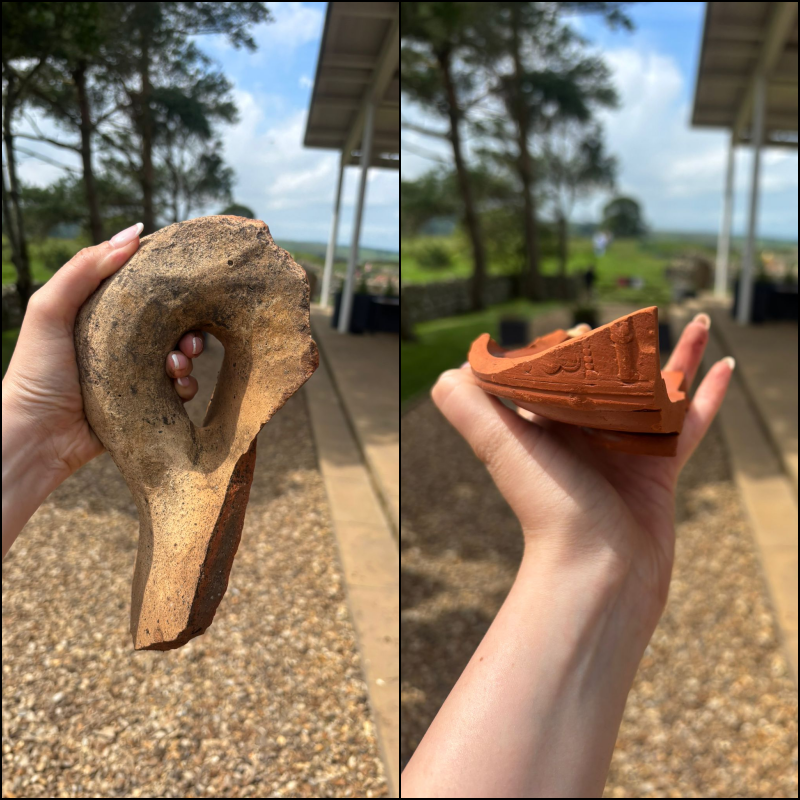
We clearly don’t get bored here with all this diversity. Now let’s hear some of the highlights from my amazing post ex team directly. Sandy and Roberta say: ‘As ‘more mature’ volunteers whose knees could no longer happily cope with digging, two of us very much appreciate the opportunity to remain involved, having dug for some years at Vindolanda already’. Conversely, as a first timer, Dave explains: ‘I am finding everything new and fascinating. Every new bag that we are given is an exciting opportunity to dig further into the Roman story here at Magna.
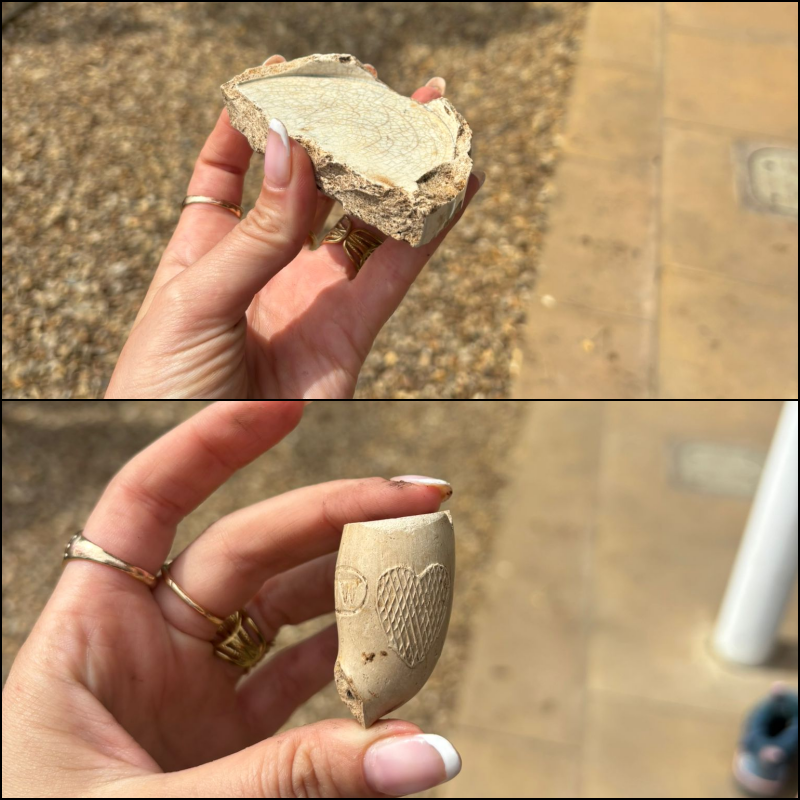
We insist you come and see us and some of these finds on your next visit at Magna. Cristina and the Post Ex Team.
4th July
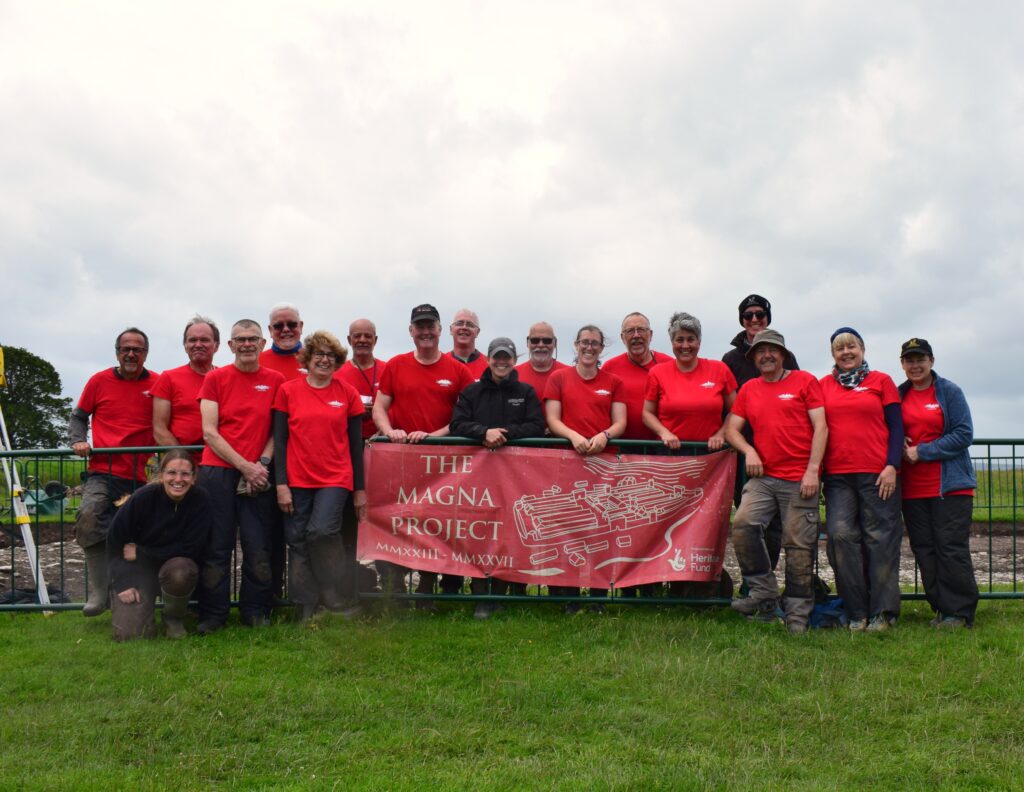
What a great end to Period 6! A little bit of rain to chase us off the trench today, but we managed to get a full section of our first ditch which was one of our primary goals for this week. To get this section, we had to battle constant flooding from both field drains which have started freely flowing now that the rain has returned. Nevertheless, with lots of hard work, minor environmental engineering, and ample petrol for the pump, we have successfully recorded the ditch. This section, which is over six meters wide, showcased a stepped ditch with an ankle breaker base and a stone revetment along the southern edge. These features showcase the elaborate defensive features that the Romans used when creating the northern ditches of the fort. The next steps in this area will be to finalize any environmental sampling needed from the ditch. Unless our sampling uncovers any additional finds (which is always possible!), we’ve finished the ditch with a total of 34 shoes. The final shoe was pulled out this morning and has beautifully preserved uppers and some decoration stamped into the leather. Franki
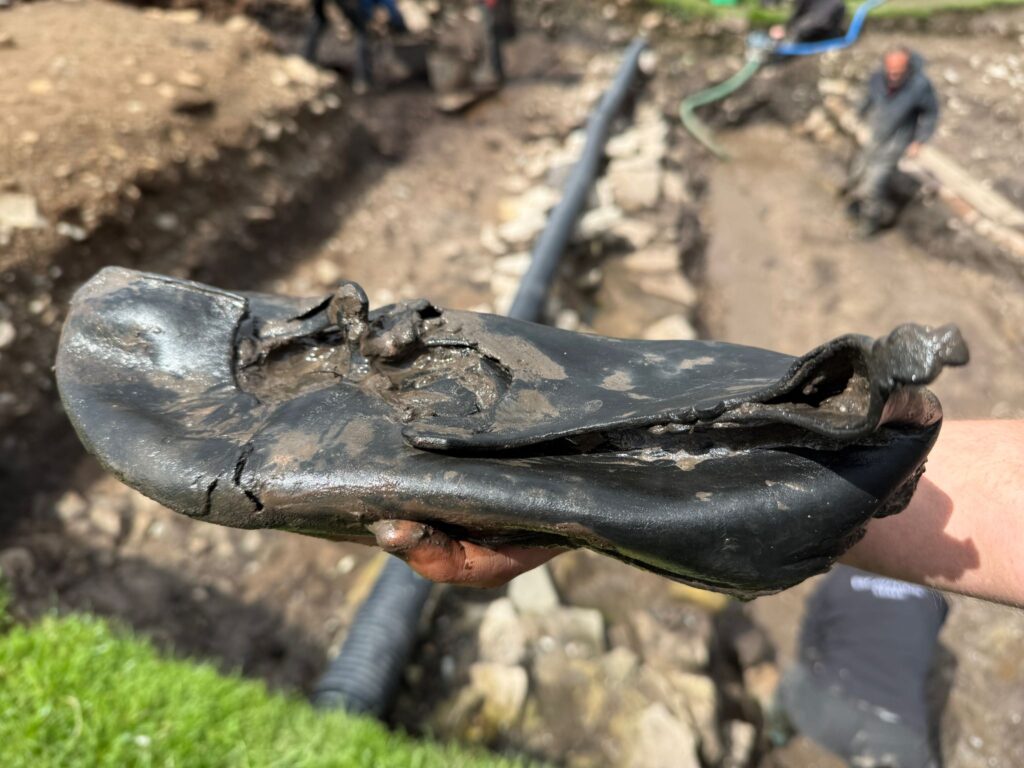
2nd July
Back in May we were excited to report the first discovery of shoes for the 2025 season, and the surprising size of one of them! In the weeks since then work has continued excavating the anaerobic fills of the ditch, and shoes of all shapes and sizes have been found. Check out our press release for more information and to hear from Associate Professor at the University of Western Ontario and Vindolanda’s shoe specialist, Dr Elizabeth Greene.
One of the most interesting things I’ve noticed over the last few weeks of excavation is the difference in preservation between some of the shoes we’ve found. While there have been some amazingly intact examples with their upper still attached and decorative details still visible, others have definitely suffered the effects of decay. For the majority of our shoes only the soles, which are the more robust than the uppers, now survive. In more extreme cases we found evidence of leather objects that had decayed away completely, leaving only a fibrous black stain in the soil.
This is particularly noteworthy given the scientific research being carried out as part of the Magna project, which aims to investigate the impact of our changing climate on the buried archaeology. Material evidence like this from archaeological remains helps to support the data being gathered from our monitoring stations and provide a visual representation of what could happen to the organic artefacts if conditions below ground continue to deteriorate.
As so often happens in archaeology this discovery has given us more questions than answers and the identity of the people who wore these shoes remains one of the most intriguing. Conservation of all the shoes is ongoing, and further research will hopefully shed more light on the owners of these items. Meanwhile excavations will soon be moving inside the fort itself to uncover more evidence about who the inhabitants of this site were and maybe even find out why some of them had such large feet! Rachel
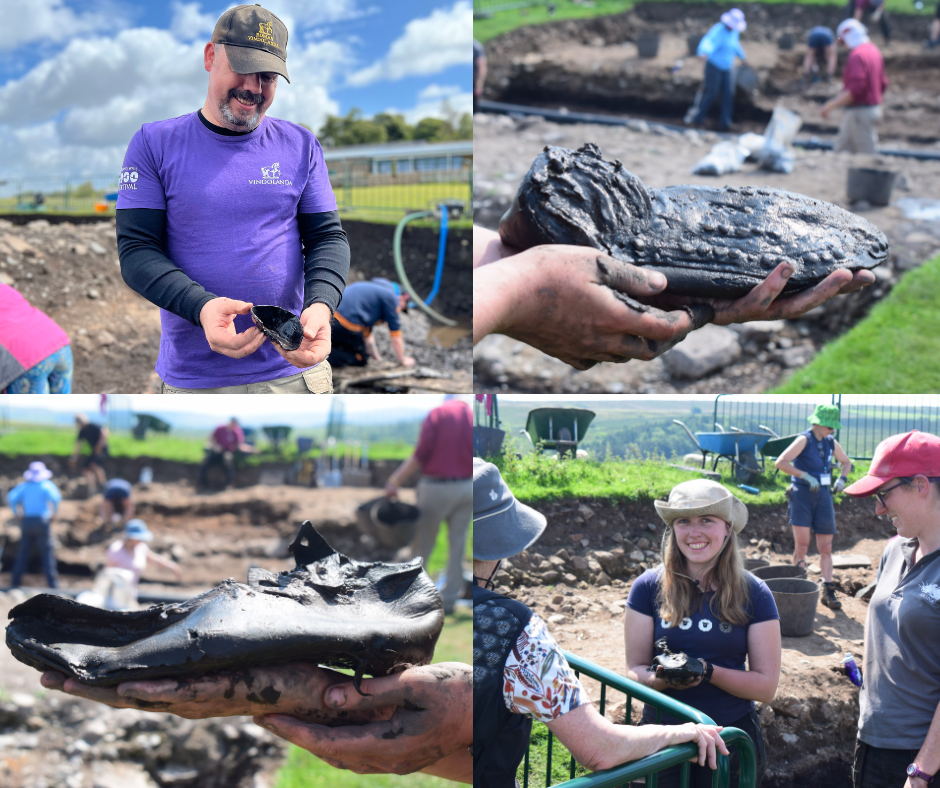
28th June
As we come to the end of Week One of Period 6, one of our volunteers, Tom, reflects on what is has been like to come back to Magna for his second year of excavating. Sophie
This is my second year digging at Magna. I used to dig at Vindolanda back around 2010-2012 with my two sons, but when the dig slots changed to a minimum of two weeks, that became difficult for us to all take two weeks out at the same time – life sometimes gets in the way of what you would love to do!
Coming back at Magna has been brilliant. There is so much to be discovered, both in terms of the artefacts that come out of the ground and the overall layout and sequence of the forts, ditches, roads and Vallum. And all of this is complicated by drains and tracks that were constructed by farmers in the last 200 or so years.
I have been lucky to find some fragments of unusual Samian ware, parts of amphorae, a flagon and pots, and lots and lots of CBM – Ceramic Building Material – what I have learnt to call all of the broken bits of Roman tiles, bricks and roofing that turn up wherever the Romans were dumping stuff or infilling ditches.
However, a massive part of volunteering isn’t just the items one finds or the layout questions that get answered. It’s also about the great people with whom you spend time – fellow volunteer diggers from all around the UK and beyond who share the interest/passion but also have fascinating backgrounds and stories to tell. And, not forgetting the wonderful staff of archaeologists, specialists, support staff and local volunteers of the Vindolanda Trust.
Some friends think I am mad, at the age of (nearly) 69, to spend two weeks getting muddy, sweaty and doing some reasonably strenuous manual labour – but I wouldn’t miss it for anything! Tom Volunteer
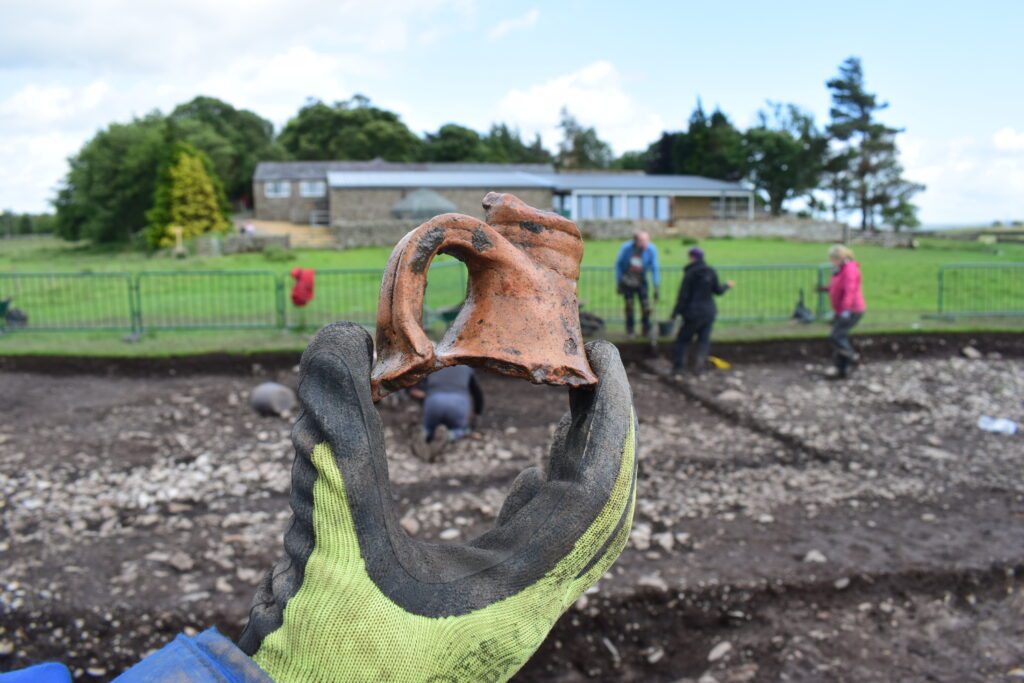
25th June
I can’t believe we are rapidly approaching halfway through the 2025 season already, especially as the site continues to throw up more surprises and mysteries on a daily basis.
If you have visited the site or been following the entries from our volunteers over the last couple of weeks you may have seen talk about the third fort ditch being excavated and anaerobic deposits being uncovered inside it. However, all was not as it first seemed in this area and upon further investigation it turned there was no defensive ditch there at all! Instead, what we had found was a much shallower feature sitting above the natural peat bog. This is the southern area of the bog we excavated around the post-medieval well last year, proven by the frequent spreads of branches and even a root system of ancient trees found throughout the deposits. This has left us with questions surrounding just how many ditches existed to the north of Magna in the Roman period, and where they all are, something we are working on answering this week with excavation focussed at the northern end of the trench around the cobbled road.
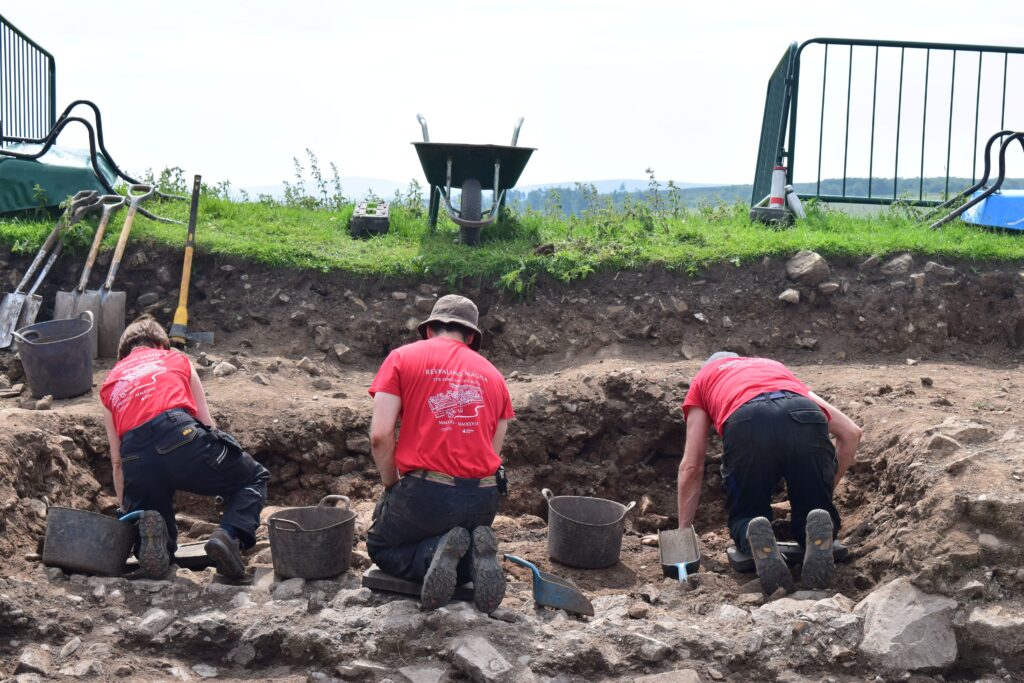
Meanwhile in the first fort ditch yet more phases of use and reuse have been identified during excavations. Against the south edge of the ditch, below the later stone and ceramic field drains, coursed Roman masonry started to appear amongst the anaerobic deposits. This caused a brief moment of consternation; had the Romans really built their fort wall inside the defensive ditch? Thankfully no, as it turned out this was part of a retaining wall built up the south side of the ditch to support the fort wall on the bank above. In front of this the soldiers had dug two different ankle breakers; small additional slots dug into the base of a defensive ditch designed to trap an attacking enemy. The pale, dense clay that formed the base of these features seemed a close match for the natural geology here at Magna, suggesting this might be the original cut from the ditch. Much to our surprise however, when digging a sump into this layer to help combat the ever-present flooding, both butchered animal bone and leather were found in this layer! This means we still don’t know how deep this ditch was or what else might be waiting for us in its depths when we resume work in this part of the site. Rachel
20th June
Well done to our amazing Period 5 team! Another fabulous week here on the Magna Excavations and we look forward to welcoming Period 6 on Monday! Sophie

19th June
Having only lived in the northeast of England for the past two-ish years, I can say with certainty that this summer feels very different than the previous two – and our weather station and environmental probe array, Wall-E, agrees with me. There is a vast difference in rainfall from 2024 compared to 2025. The months of January, February, March, and May had on average three times less rainfall this year; April, on the other hand, had seven times less rainfall.

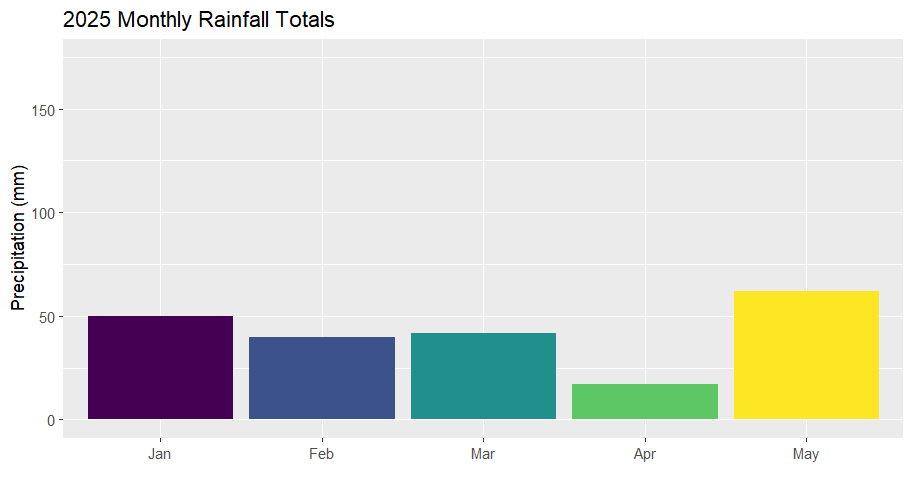
This considerable lack of rainfall has a notable effect on the site. Across the site, you can see how much the peat has desiccated by the differences in the ground level. When our Site 2 piezometer was inserted into the ground in 2021, its blue PVC pipe was level with the surrounding soil. Now, the pipe is 5cm above ground level, aptly demonstrating how much the ground has shrunk over the past four years. This shrinkage is caused by the peat losing its waterlogged sponginess and instead becoming dry and brittle.
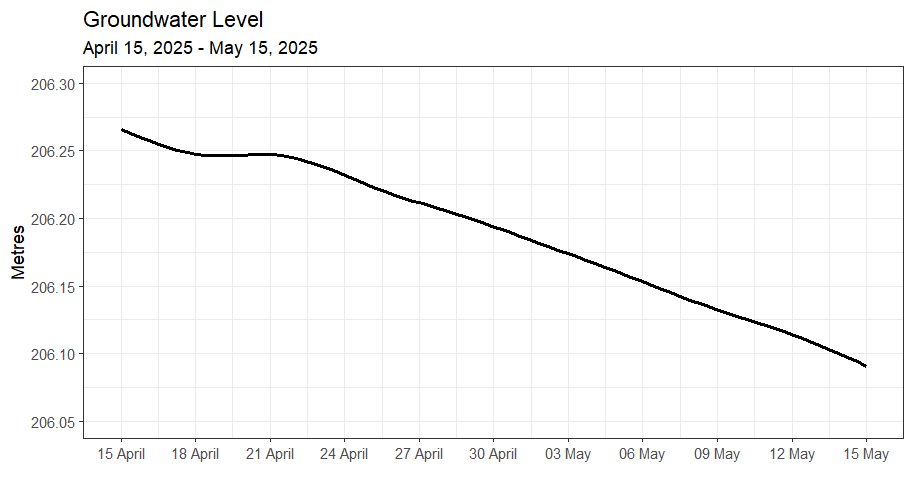
This shrinkage matches what Wall-E is recording regarding the oxidizing reduction potential (ORP) of our soil environment. On June 8th, the soil environment switched from aerobic conditions to anaerobic conditions after spending approximately 200 days with high potential levels of oxygen. This marks the longest period of time that the soil environment has been in continuous aerobic conditions since we began monitoring the site three years ago. As discussed in Chapter 10 of the recently published excavation report, there is little statistical correlation between the variables of rainfall and ORP; nevertheless, there is a connection between rainfall, groundwater level, and the moisture retention rates of our soil. As such, further research is required to fully unspool the deep connection between the fluctuations in our soil environment and the rapidly changing climate. Given the current rate of change, however, we have a limited number of years left to figure it out. While all the organic material remains that we have been finding in our ditch this year have been incredible, they are almost certainly feeling the effects of climate change. We are very fortunate to be able to excavate these areas now, before climate change irreversibly damages these areas beyond salvation. Franki

17th June
If you would like to dig a little deeper into the archaeology of the Magna Project, we have published the second in a series of 5 annual excavation reports. This report is available to download as a free PDF. Simply click this link to obtain your digital copy of the 214 page report. For sherd nerds, Cristina has a look at the pottery assemblage from last year, Rachel takes us through the activity at the site, and Franki sifts through the soil to understand what is going from an environmental perspective. Sophie
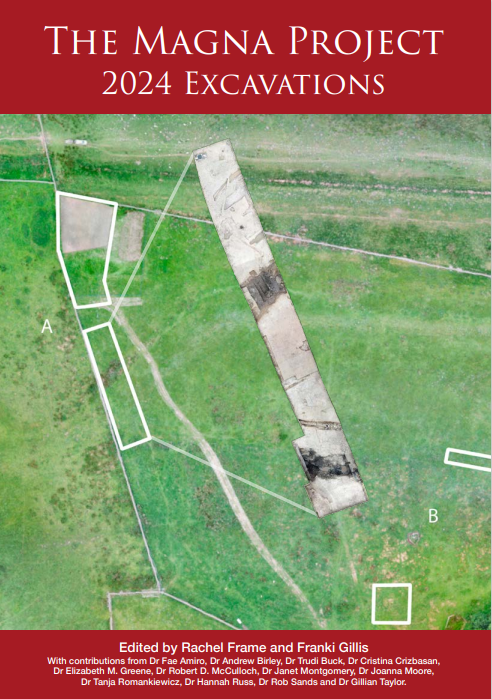
16th June
Another week has begun here at Magna, with the sunshine trying to make a break through the clouds and the continued enthusiasm from our wonderful Period 5 crew! Michael, a familiar voice here on the Dig Diary from the start of Period 5, gives us an insight into his experience of the first week on site. Sophie
First, let’s begin with a bit of a Latin lesson. Magna: Adjective, large/great/big/vast/huge. An apt name for everyone’s favourite new Roman fort excavation, as well as a good description of the tasks presented to Period 5 in the first week.
Define a road… Define the edge of said road… Find the anaerobic layer in a possible new ditch… Which leads to a quick archaeological lesson. What makes up a road? Cobblestones. Does the presence of cobblestones always mean a road? Fortunately, no. Which means after much effort we have a road with a clear edge. Well done, two tasks accomplished, moving on.
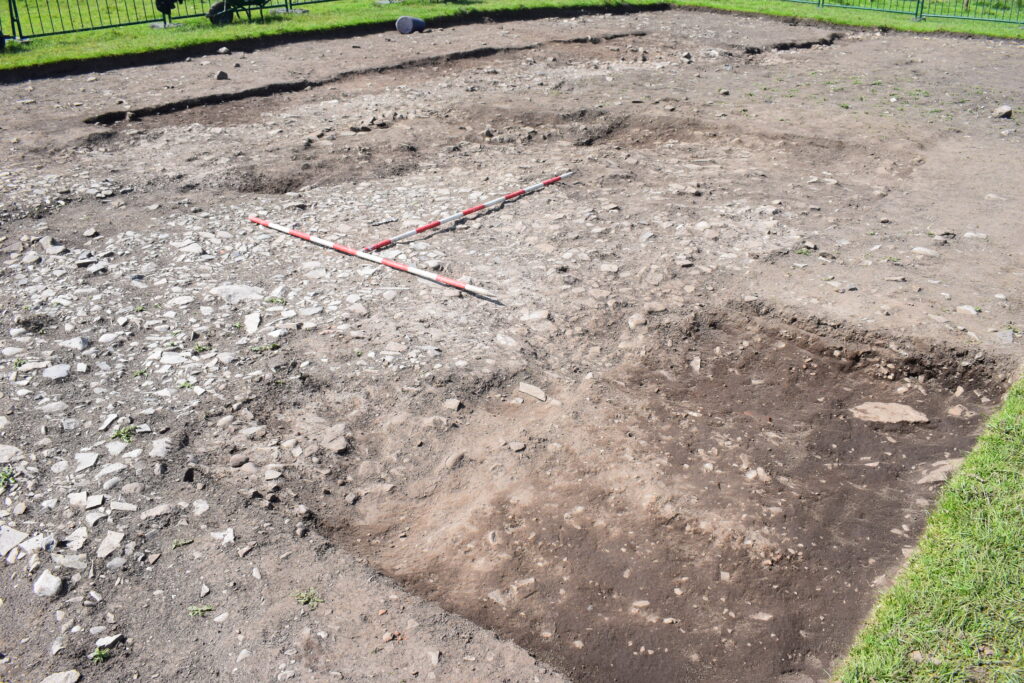
Two defensive ditches have been found and worked by the previous periods from this year. They have done a marvellous job (and we are grateful), and good things are being discovered.
A third ditch had been defined, but there was hesitancy in saying we had found the original sides of the ditch. So, dig down deeper and see what we find, hopefully anaerobic deposits. Does one simply dig down to the anaerobic and call it a day? Ha, no. Digging (spading) would be too much brute force, and the probable result would be passing through the anaerobic layer. While this could lead to quick finds, proper archaeology is patient, and layered, and patient. Which means trowelling. And more trowelling. Followed by……trowelling. Because you are looking for a subtle change in the appearance of the dig area. Small actions, patient progress, Magna results.
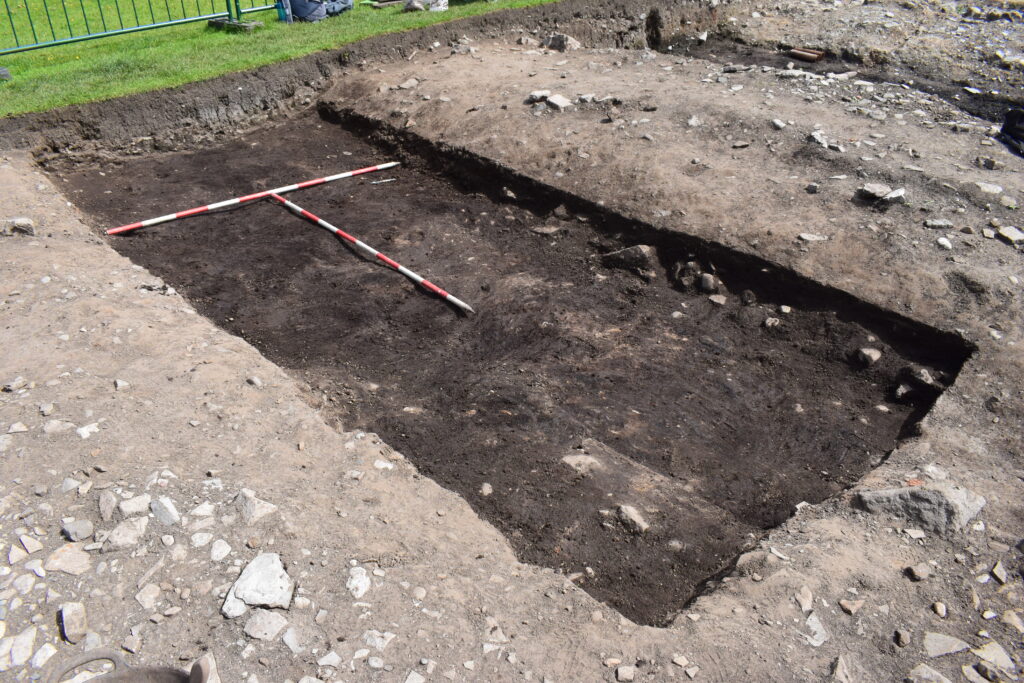
Period 5 did well with the tasks, and Ditch 3 is now set to go deeper again.
The group are having a splendid time. The work is hard and satisfying, and the teamwork is abundant. We are excited about what the next week holds! Michael Volunteer
12th June
Earlier in the excavation season, one of our very own members of the Magna Team, Elizabeth, swapped her usual role welcoming our visitors into the Roman Army Museum and spent two days with the archaeological team in the trenches at Magna. During her time on the excavations, she came across a particularly interesting piece of pottery. It’s the first stamped piece of pottery from the Magna excavations, and we couldn’t be happier for her!
Below, Elizabeth reflects on what her experience in the trenches was like…Sophie
“I feel so lucky to have had this amazing experience. There is an air of positivity and shared fascination between everyone. Getting a peek into the world of archaeology as well as meeting wonderful people so full of knowledge who are more than happy to share it. I loved my time in the ditches, down to shifting every heavy wheelbarrow. It was an honour to dig and sift through the anaerobic mud.
Until you’re there you don’t fully get a sense of how much stuff actually comes out of the ground, lots of little pieces of wood, pottery scraps, all coming up. It’s just beautiful to think they’re from a completely different time, not held since the Romans, like little windows to the past, especially when the bigger things are uncovered and can tell more of a story.” Elizabeth
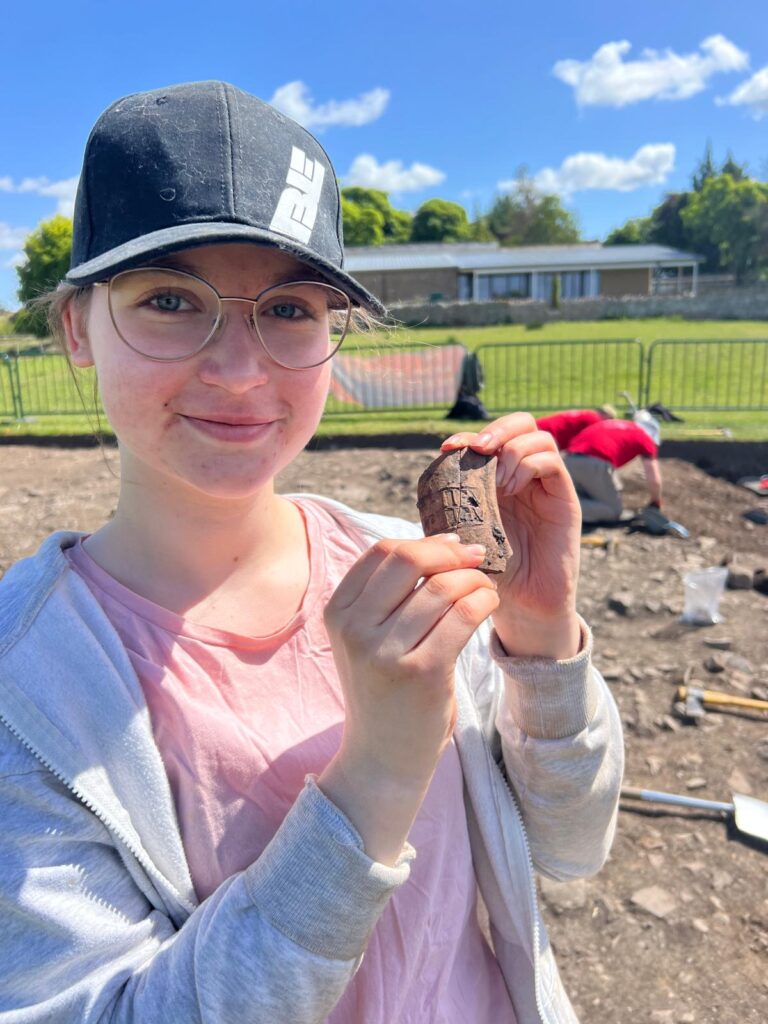
9th June
This morning we welcome our new team of excavators to Magna for Period 5! As we approach the halfway point of this excavation season, we excited to see what else there is to uncover here on site – who knows what secrets the soil still holds? While the new team is gearing up to dig into the unknown, one familiar face has taken a moment to pause and reflect. Michael, one of our returning volunteers, shared some thoughts about his experience on site last year… Sophie
“Members of the team, regardless of experience level, very kindly helped others in so many ways through our time together. These things were especially important in Week 2, with the threat of poor weather looming daily for the end of the fortnight.
Taking someone’s bucket to the barrow, in addition to your own. Taking a barrow to the tip, and then on return taking another one because it was full, also. Prising and carrying stones, then doing it again with more, oof-inducing stones. Helping to clean an area before a break so everything looks nice and even, not just your spot. Not moving to possibly a more prime area for a find because the person you’ve been working with might need help that you have picked up on, but someone else might not.
Moving, moving, moving, because it WAS going to rain, as indeed it did.
Also, the kindness from experienced volunteers to first-years sometimes went above and beyond. From an experienced digger to a rookie…
“All right, take a look here. See that red bit sticking out the edge? That’s Samian pottery, and that is what we are after. Get your trowel, because this piece is yours- ease it out.”
Yes, giving up a Samian ware find to someone else. Just so the person has the chance to experience the challenge, and the joy, of removing something from the ground that was last seen almost 2000 years ago.
Through our time finds were made. Possible mysteries were uncovered. But most importantly, acts of kindness were shown.
…and looking forward to Magna, Period 5, 2025…
We eagerly await what this year’s session holds! A new volunteer crew to work with, a new area of Magna to uncover, and new mysteries to dig into (pun, of course, intended). We are encouraged and excited by the progress made at the site so far, and hope to continue the good work done by the previous teams. Beginning 9 June, welcome to Period 5, and best of luck not only in what we do but the ways we do it.” Michael Volunteer
6th June #VolunteersWeek
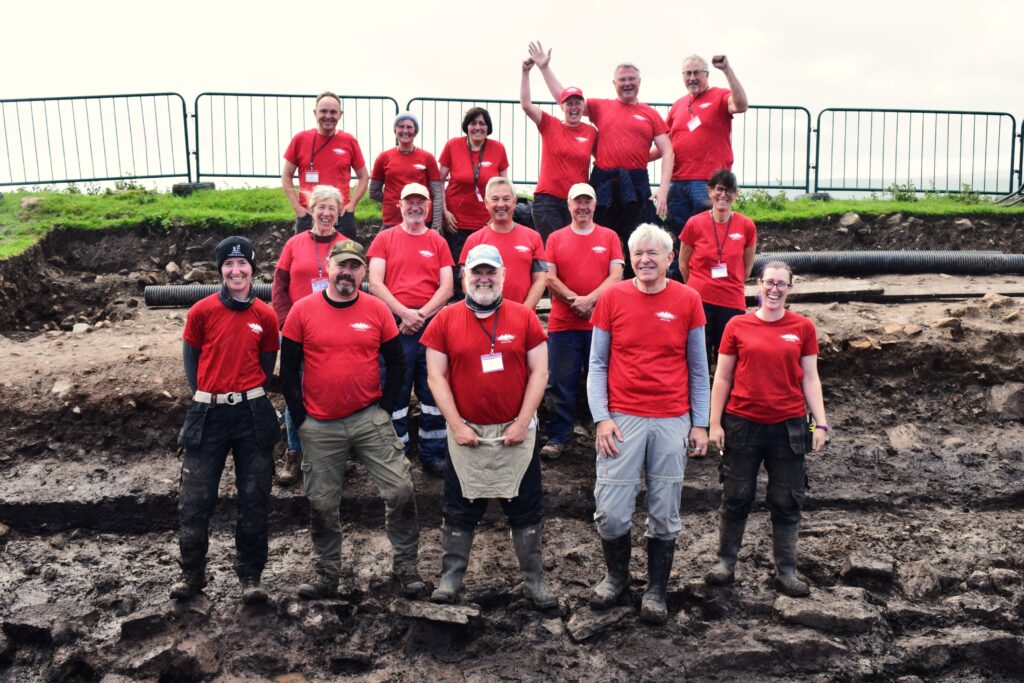
It’s the final day of Period 4, and the team have done an incredible job over the past couple of weeks. A well deserved, celebratory Photo Friday – even in the rain! As we look forward to welcoming Period 5 on Monday, we’re looking back on some exciting finds from this week. Sophie
The weather may be cooling down here in Northumberland, but things are definitely heating up in the trench with some exciting finds starting to come from the lower fills of the first fort ditch.
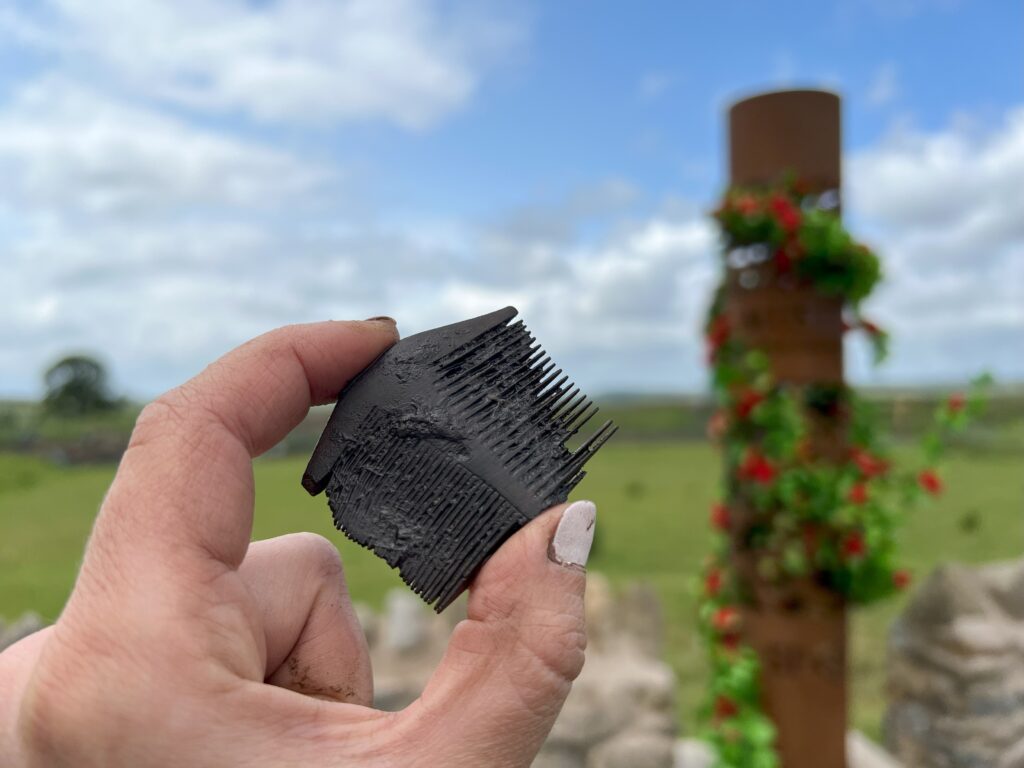
One of this week’s highlights was a wooden comb, found not long after the team started digging out the next layer of ditch fill. Although broken with only one end found (so far!), almost all of the fine teeth have survived. These demonstrate a high level of craftmanship, being cut into the block of boxwood along faint guidelines. Finds like this provide a tangible link to the Romans living here at Magna as they are so immediately recognisable and relatable to our modern lives; some things really never do change!
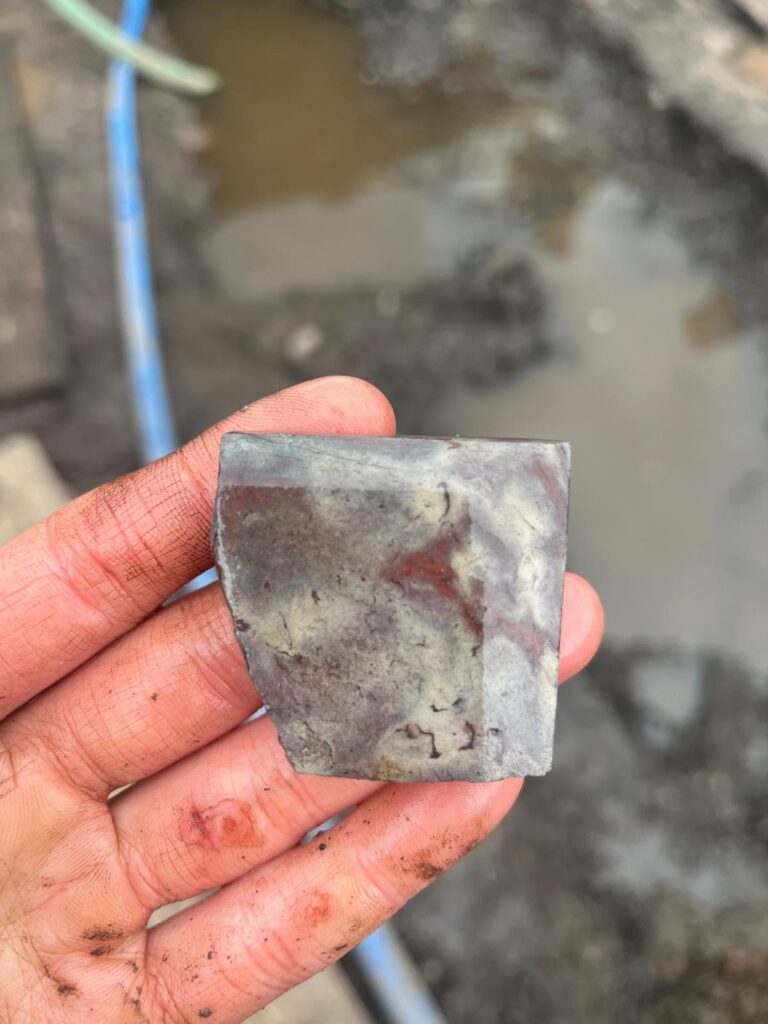
Not all of our star finds are organic however, as yesterday we found the corner of a marble make-up palette. These flat, rectangular palettes would have been used to mix together dry pigments with a fat or oil to form a paste that could then be applied to the lips, eyes or face. Different coloured pigments could be used to create things like lipstick, blush, and eyeliner. Objects like this remind us that not everyone at Magna was a soldier in the Roman army and that there were plenty of women living in and around the fort as well. Rachel
4th June #VolunteersWeek
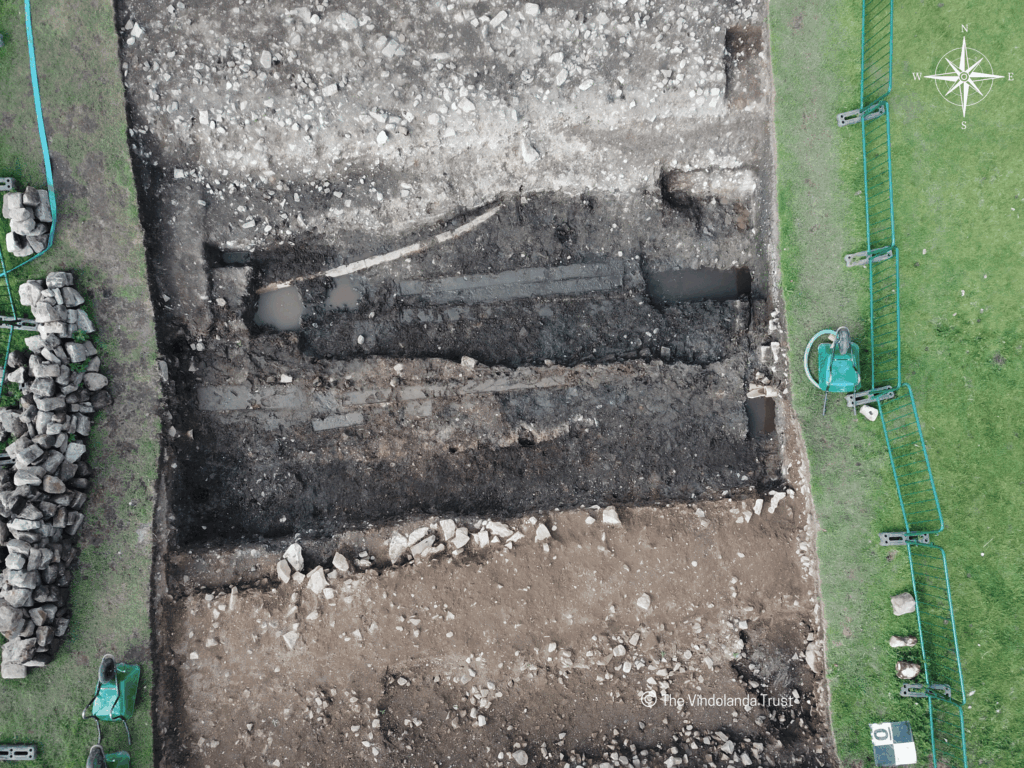
We’re continuing the second week of Period 4 at Magna with excitement and energy as we dig down into the northern defensive ditches just outside the north wall of the fort. Excavating into these rich, anaerobic layers is giving us new insights into the site’s past and every bucketful brings these stories to light!
However, none of this would be possible without our incredible volunteers. From the dedicated excavators and post-excavators to our passionate guides and activity volunteers, the Vindolanda Trust is powered by an amazing community of people who give their time, skills, and enthusiasm so generously.
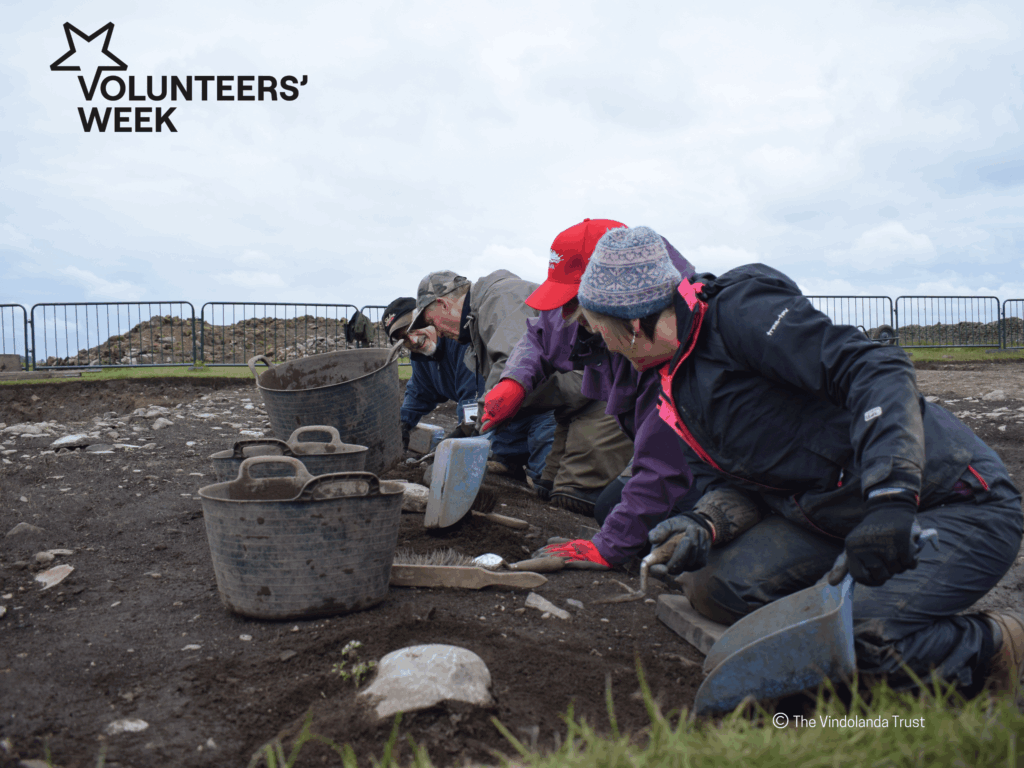
This #VolunteersWeek, we want to say a HUGE thank you to every one of you. Whether you’re in the trenches helping us uncover the past, working behind the scenes to process our finds, or bringing the site to life for our visitors – you are the driving force of this project, and we are so grateful.
If you’re visiting us this week, come by the trenches, take a tour, and help us celebrate the amazing impact our volunteers make every single day. We couldn’t do it without you! Sophie
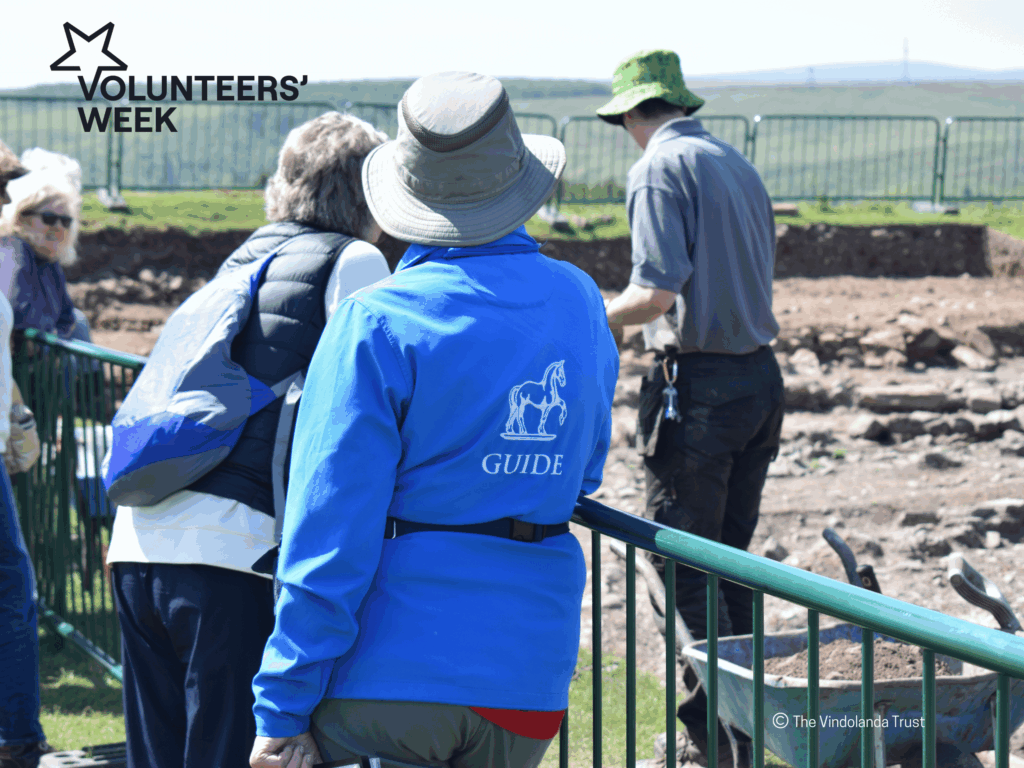
29th May
It’s been a great week here at Magna as we welcomed our wonderful Period 4 crew to the trench on Monday! With trowels in hand, they’ve hit the ground running, de-turfing the remaining areas and continuing to excavate down into the fort ditches. To catch up with what has been happening on the excavations so far, check out our recent video update here.
Among our team is Judith, a familiar face from the 2024 season, who’s returned to Magna this year. Reflecting on her experience, she shared what it’s been like on these first few days back in the trenches. Sophie
I am writing this as a returning volunteer. Last year, we dug an area which , we were told this morning, is consistent with a possible Tannery site. All that you can see today is infill and regrowth.
We were introduced to this years trench. It contains some very exciting military ditches, you can see the organic soils in filling the ditch are clearly different in colour and texture from the side edges of the ditch. Whether we still feel that confident when we start to dig, is another matter!
However, that is for another day. This afternoon‘s work was tough removal. We put our backs into it (literally) and finished the job. Tomorrow, I expect that we will be clear cleaning back, hopefully to see part of a cobbled road.
It’s great to be back. Morale among the diggers is very high. Bring it on! Judith
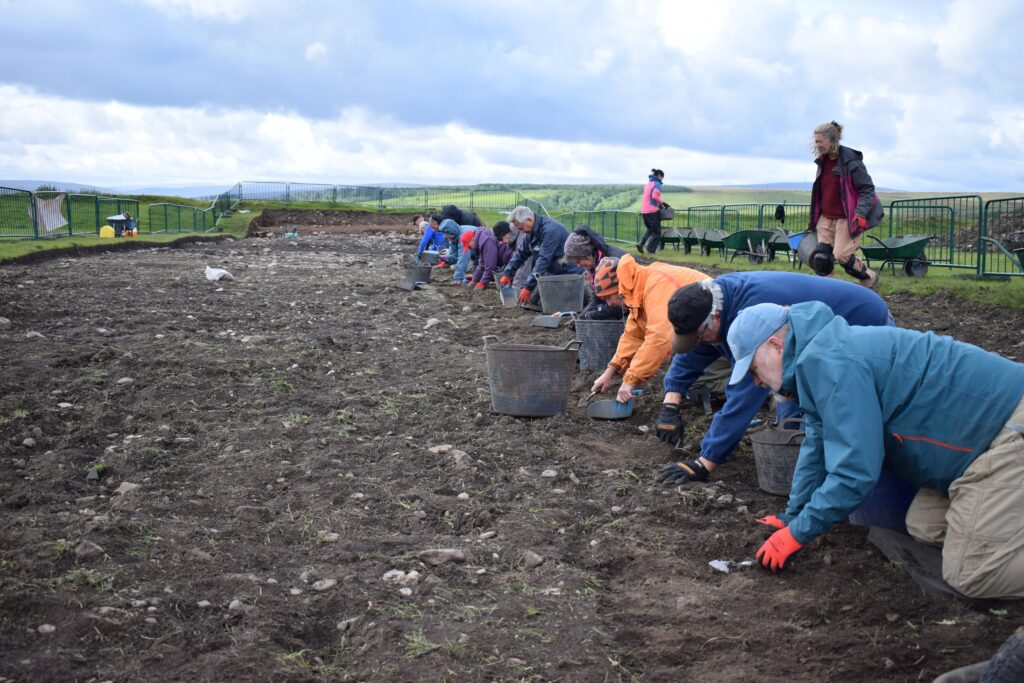
23rd May
Huge thank you to our Period 3 crew for all their fantastic work over the past couple of weeks!

21st May
The discoveries continue as we delve ever deeper into the anaerobic fills of the first fort ditch, with both organic and inorganic finds being found by our eagle-eyed team as they sort through the soil. There have been several different styles of pottery and two wooden tent pegs but the real star finds this week has been our first two shoes!
While we mentioned shoes in the last dig diary these were fragmentary pieces that can only provide limited information when analysed. The two that were found on Monday are more complete and can tell us much more about shoe manufacturing techniques and the individuals who may have worn them in the past.
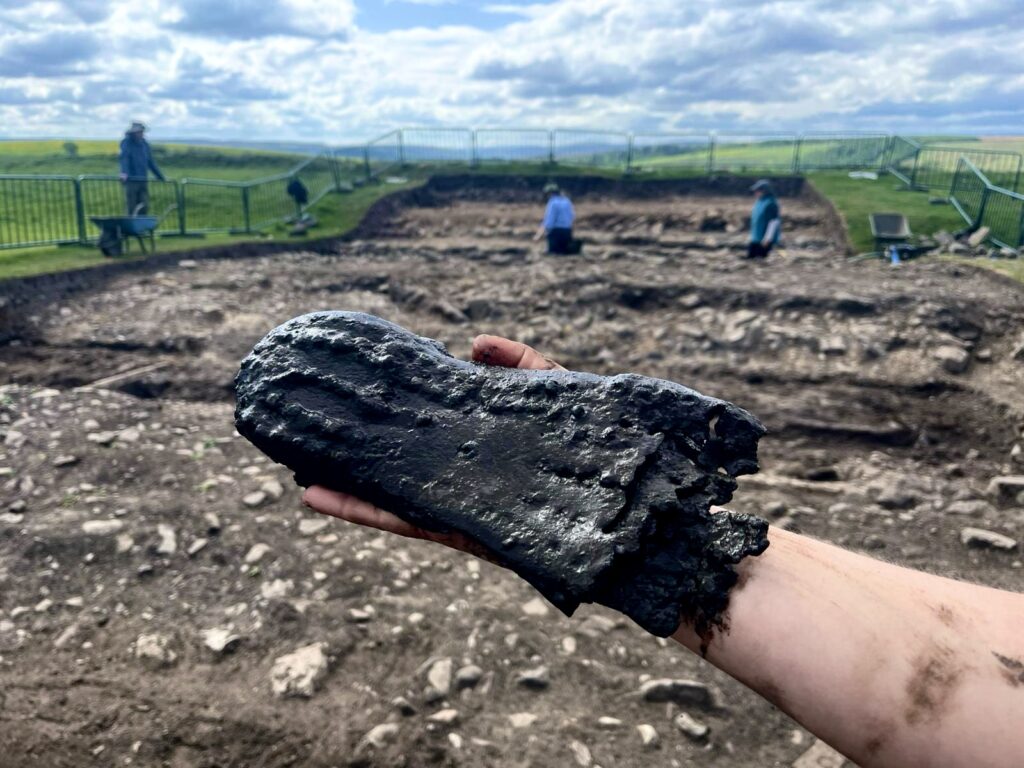
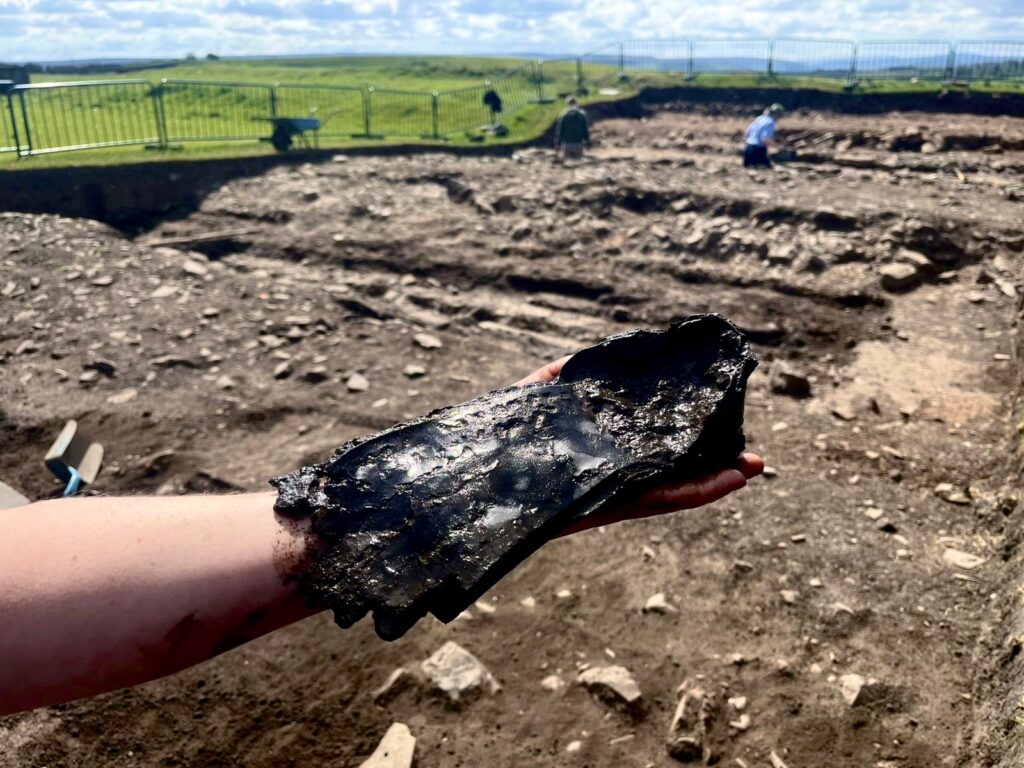
The first shoe to come out seems to have all of its sole layers intact, along with part of the heel area still attached and most of the hobnails in the outer sole. This gives us a really good look at how Roman shoes were made: multiple layers of leather were used to form the sole, held together with thongs, stitching and hobnails. These also reinforced the outer surface for walking and are found on many styles of shoe. Sadly, the toe area is missing meaning that we can only estimate its original size, but it was still clear this would have been a large shoe when complete.
Jo, one of our period three volunteers, describes the moment when she discovered this incredible find…
It’s always exciting to find anything that hasn’t been touched for 2000 years but a shoe is such a personal item; it really puts you in touch with the people who used to live at the fort. Getting wet and muddy and digging in the wet is just a bonus!
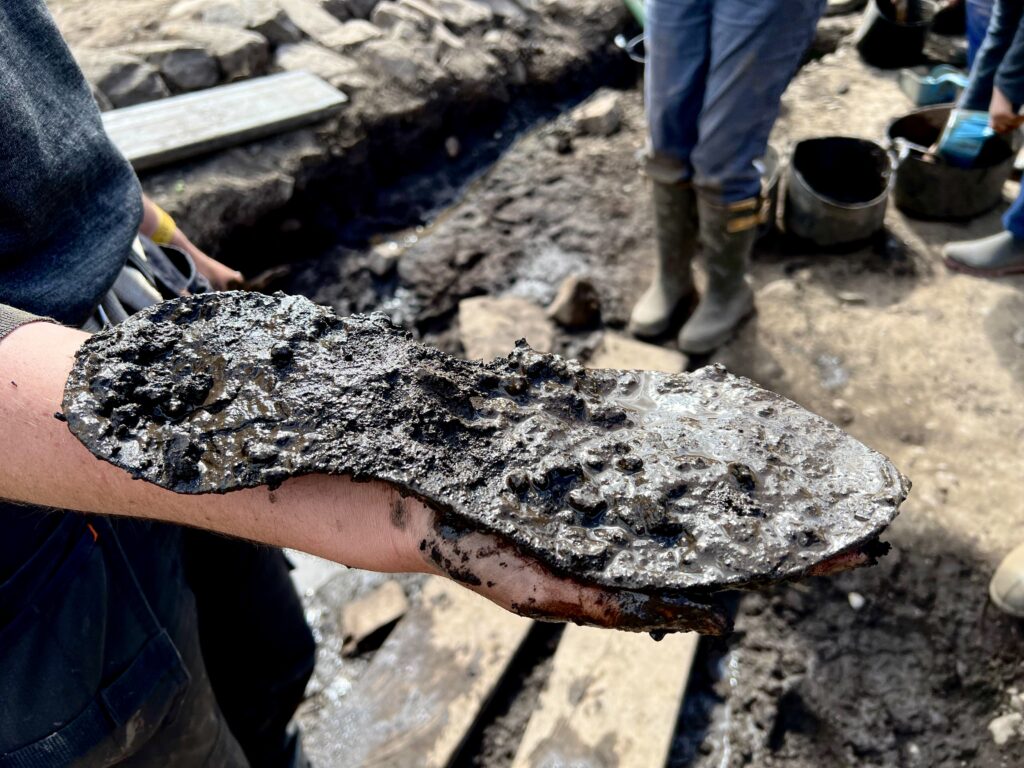
There was no doubt about the size of the second shoe we recovered from the very base of the ditch, was intact from toe to heel and immediately drew impressed gasps from volunteers and staff alike. Although in this case only one of the several sole layers, the sheer size of the shoe and guesses about who could have worn it dominated the conversation. Measuring in at 32cm long, the equivalent of UK men’s size 12-14 in modern footwear, could this one be the largest in the Vindolanda Trust collection? We certainly look forward to finding out!
These finds are just a few more examples of the artefacts and information at risk from our changing climate so we are very grateful to still have the chance to find such personal connections to the past. Here’s hoping for many more as we continuing excavating the fort and its ditches! Rachel
19th May
Today marks the halfway point of Period 3, and the crew are making solid progress into the anaerobic deposits of the northern ditches here at Magna Fort. These ditch fills continue to deliver some exciting finds – including the remains of leather shoes! Don’t miss the picture of a fabulous (and very tiny!) leather shoe over on our Facebook page.
But it’s not all about the shoes… Digging into the secrets buried beneath Magna is what keeps our volunteer, Dylan, coming back year after year. This is his third season with us here at Magna, so take a moment to read his reflections on why Magna keeps calling him back. Sophie
May rolls around once more and I make my fifth annual pilgrimage north to dig amongst the remains of our forebears. For the 3rd year Magna fort and its surroundings demand more attention to detail than the sister fort at Vindolanda that bewitched me with its sheer quantity of finds and breathtaking artefacts.
De turfing is “good for the soul “ they say and sure enough it is. Within a day a Roman road is exposed, going in a curious direction apparently. Not seen for 18 centuries maybe. Another puzzle for the experts to deliberate over. I’m happy to keep brushing. This adds to the wealth of knowledge for this part of our country. Being part of this process is very special and what volunteering, for me, is all about.
The first ditch North of the fort already deeply excavated by previous groups offers us the opportunity to excavate anaerobic material. This is a privilege, if ever there was one. A wooden tent peg emerges clearly whittled with a very sharp knife. It glistens fresh and bright in the sunlight for the first time in 18 centuries.
Even if artefacts aren’t found there are fronds of moss, pieces of wood and bark to marvel at. A bright green beetle carapace no more the 2 millimetres across catching the bright sun and casting a fresh jewel like iridescence beautiful to behold.
Ditch number three north of the fort is under that dry expanse of featureless earth recently manicured before the procedural photograph. What secrets does it hold? We’ll find out soon enough.
The walk back to the car park after another tiring but endlessly satisfying day. The birds and the breeze and the leaves on the tall trees whisper their memories to each other as another day comes to an end. Dylan
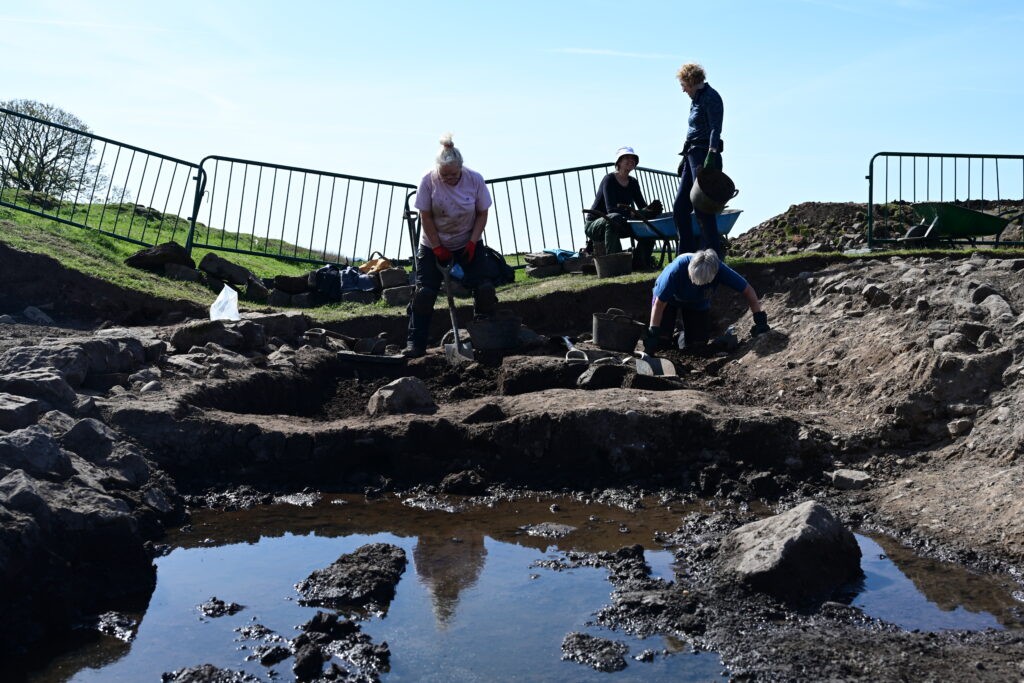
16th May
This week we focused on completing the excavations of our first and second ditches, finally breaking into the proper anaerobic deposits. Our first ditch has been a pool of bright green algae for a little while, but our lucky volunteers were able to drain this water and get into the ditch fills.
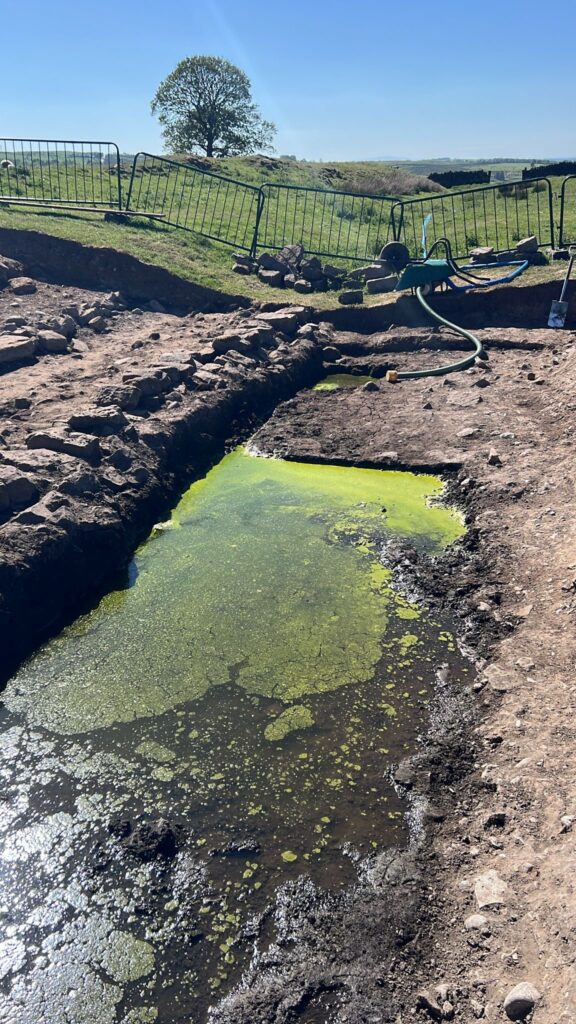
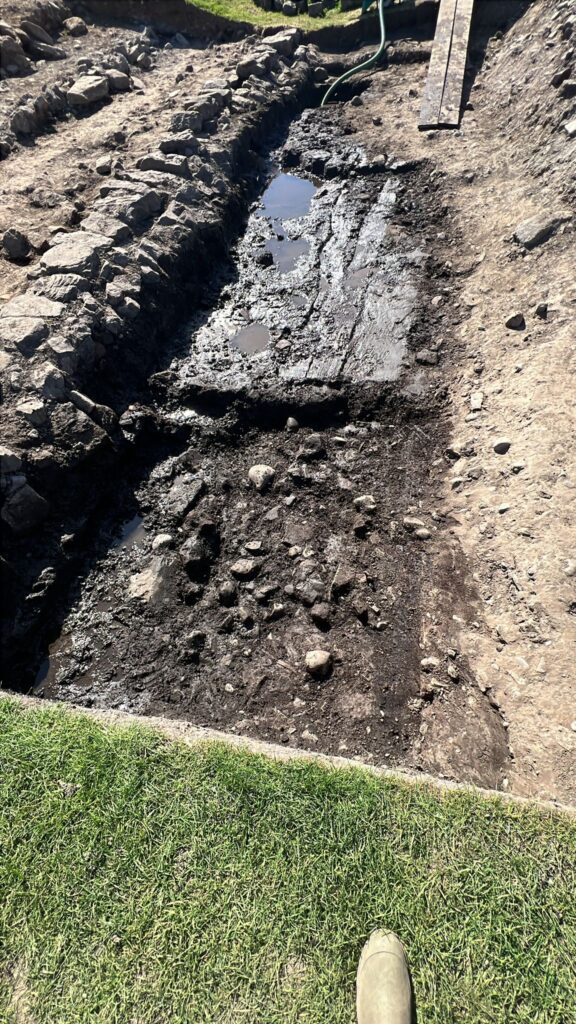
This scrap of leather from the lowest fill of the ditch shows that the anaerobic deposits are not in the best condition. Although the leather has survived, it is dry, brittle, and quite fragmented.
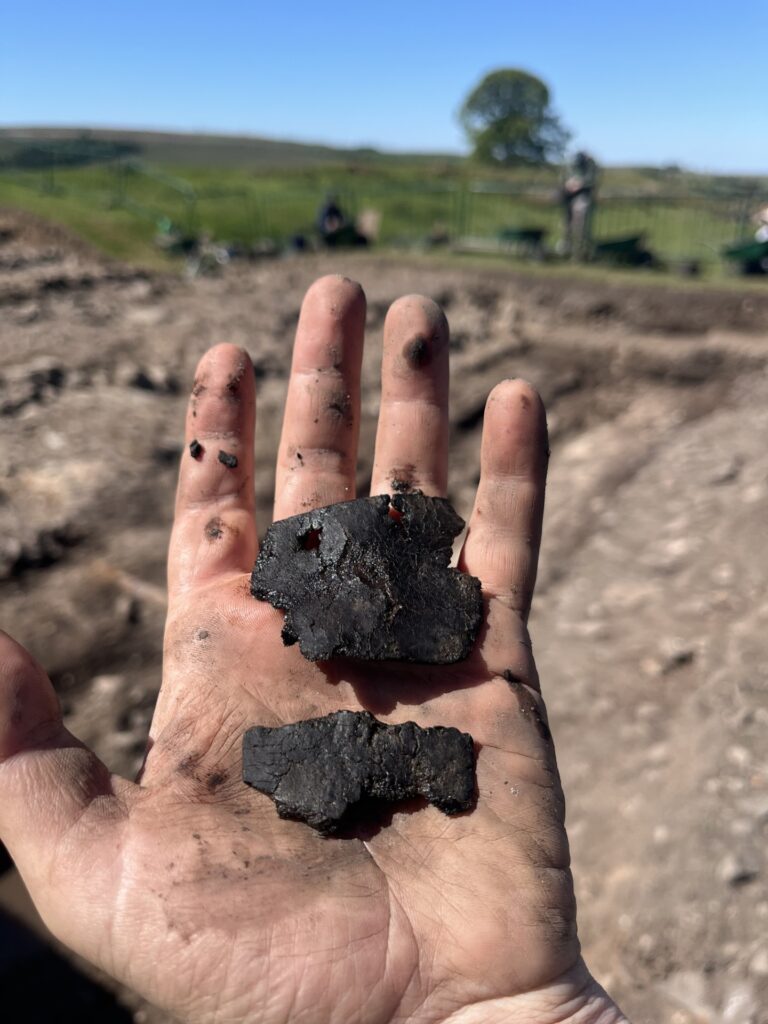
Our second ditch has now been bottomed out and revealed segmented ankle-breakers at its base. These ankle breakers are unusual on two accounts: first, they are rather shallow compared to other such ditches; second, ankle breakers are not usually segmented. As such this feature will require further research to see if we can find any similar examples from the Roman Empire.
While this sunny weather is much appreciated as we dig, the lack of rain is causing concern. This month-long dry spell is contributing to the underground changes affecting the preservation of organic material remains here at Magna and Vindolanda. At Magna, the lack of rain has caused the groundwater level to drop considerably. When the groundwater level drops changes occur in the soil environment. These changes can impact upon basic soil chemistry (such as pH and REDOX), and upon microorganisms living in it. The changing environmental conditions can in turn impact on the archaeological artefacts and reduce the preservations of organic material remains such as wood, leather and textiles.
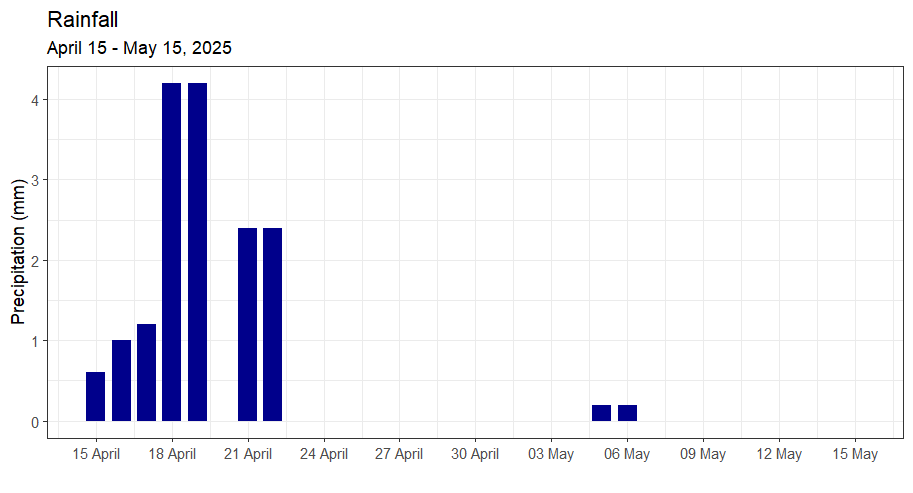
The knowledge we are gaining from our environmental monitoring is critical to understanding the impact of climate change. So although nice, this abnormally lovely warm spring, may be harmful to the continual preservation of our organic finds at Magna and Vindolanda. Fortunately, we have Wall-E, our weather station and probe array, to monitor these changes in the soil environment as they occur. Our continuous monitoring can help us develop future mitigation plans so we can salvage as much archaeology as possible. We are working with Dr. Gillian Taylor, Associate Professor of Analytical Chemistry at Teesside University and Vice Chair of the Vindolanda Board of Directors/Trustees, to help develop these strategies to preserve the remaining anaerobic deposits at Magna and Vindolanda. – Franki
12th May
We had an exciting end to period 2, and they’ve set period 3 up to have some amazing finds during their time with us. Last week, we found our first bit of scrap leather, which was likely a heel stiffener for a shoe. This bodes well for our current two ditches, and we hope to exponentially expand our collection of leather artifacts by the end of this week. We also had our first wooden object come out of the ground, likely a bucket stave or tent peg. To add onto all of this, we had our first bead of the season, a small, gilded glass bead that required eagle eyes to spot, as it was sadly a bit broken. Nevertheless, we are beginning to get a taste of what these ditches truly have to offer – and we’ve only partially excavated two of our possible six ditches! Period 3 begins today with the customary initiation of de-turfing more of the trench, but then tomorrow we’ll get right into it with further excavation in the anaerobic ditches. Franki
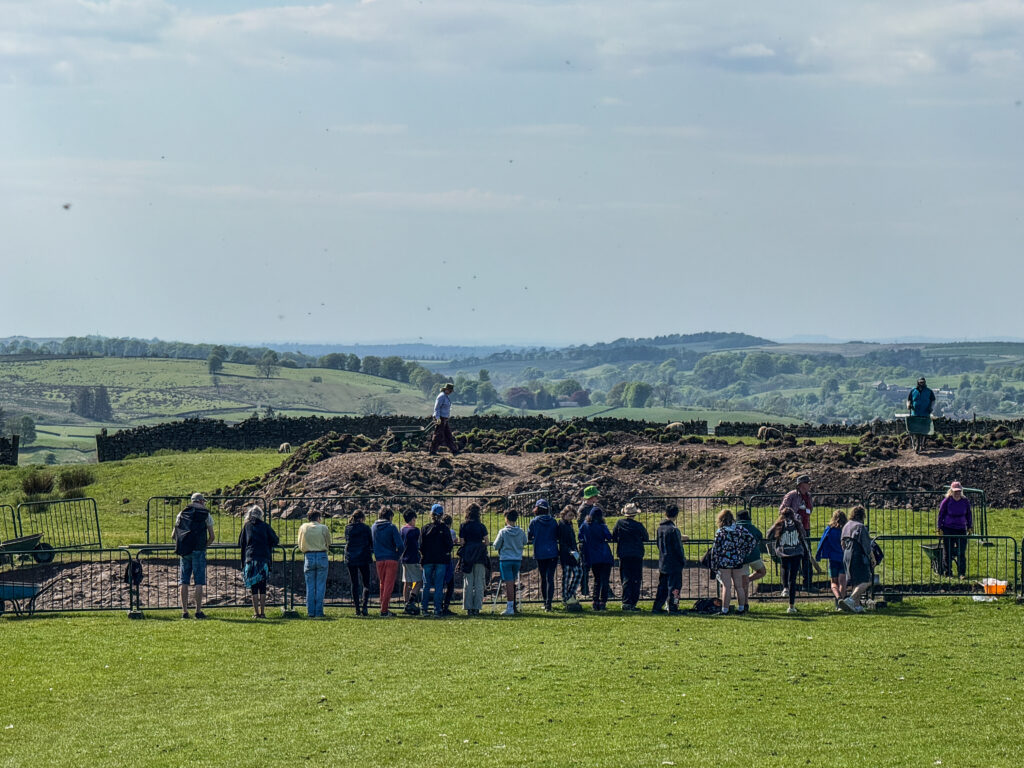
9th May
Another two weeks have simply flown past and here is our fabulous Period 2 team gathered together for a very relaxed photo Friday! On Monday we welcome Period 3 to the trenches as we continue to dig deeper into the ditches. – Sonya
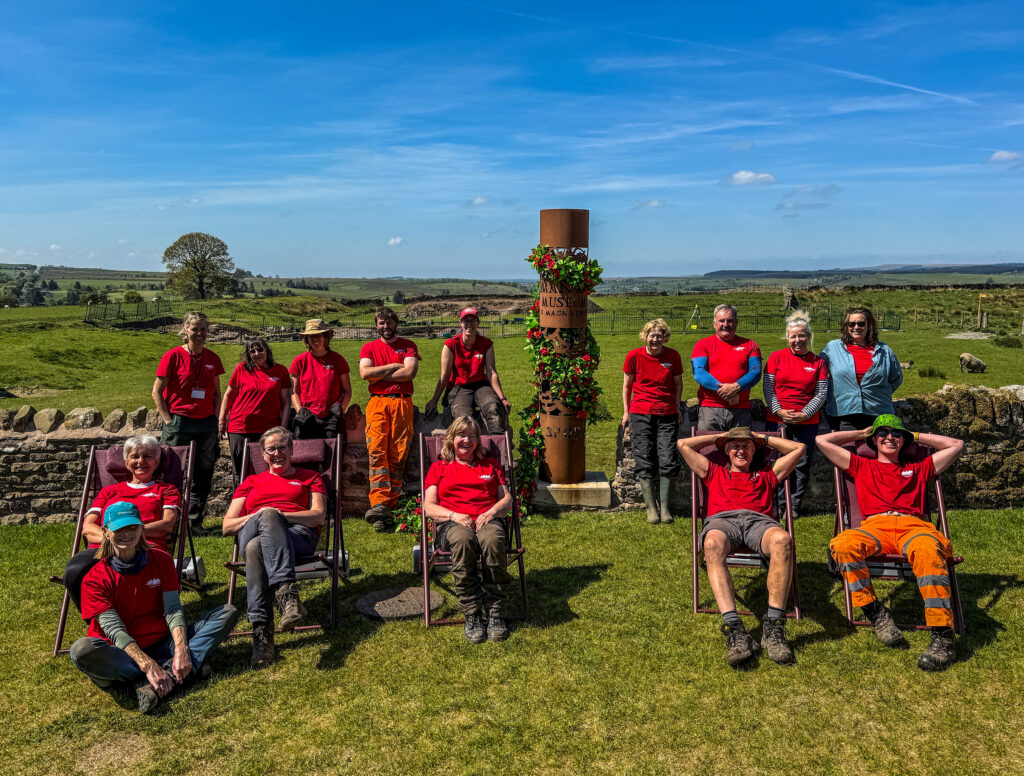
7th May
As we approach the one-month mark of the 2025 excavations there have been plenty of changes happening in the trench, answering some questions and, as is always the case in archaeology, raising plenty of new ones. The mystery of the fort wall has been solved at the south end of the trench: our previous suspicions that it has been extensively robbed out have been confirmed as only a band of mortar and rubble survive to show where it would have stood. We also have an explanation for the nearby rubble deposits we were investigating as well. These have proved to be the Roman backfill of an earlier ditch, underneath the latest fort wall. This is our first glimpse into the different phases of Magna fort and we will be exploring this further later in the season.
Not all of our discoveries have been what we were hoping for though, as two new field drains (one rubble, one ceramic pipe) have been uncovered hidden in the fills of the second fort ditch. Luckily the rubble drain is not flowing anymore, and the ceramic pipe is very close to the west edge of the trench where we are cutting steps to access the deeper part of the trench, meaning we don’t have to disturb it and risk a flood!
We are hoping to start excavating some semi-anaerobic deposits in the first fort ditch later today and we will be keeping our eyes peeled for our first organic finds, possibly some leather shoes to add to last year’s collection or even some wooden objects. Either way we will be sure to keep the dig diary updated with what we find – Rachel
If you follow @TheVindolandaTrust on Facebook you’ll have seen a lovely sherd of Samian pottery that we uncovered this week at Magna. We love sharing our photos of new discoveries. This one didn’t make the cut for our Facebook page but we thought we would share it in the diary for some true behind the scenes shots…we’ve accidentally given this ancient cup a pair of legs! – Sonya
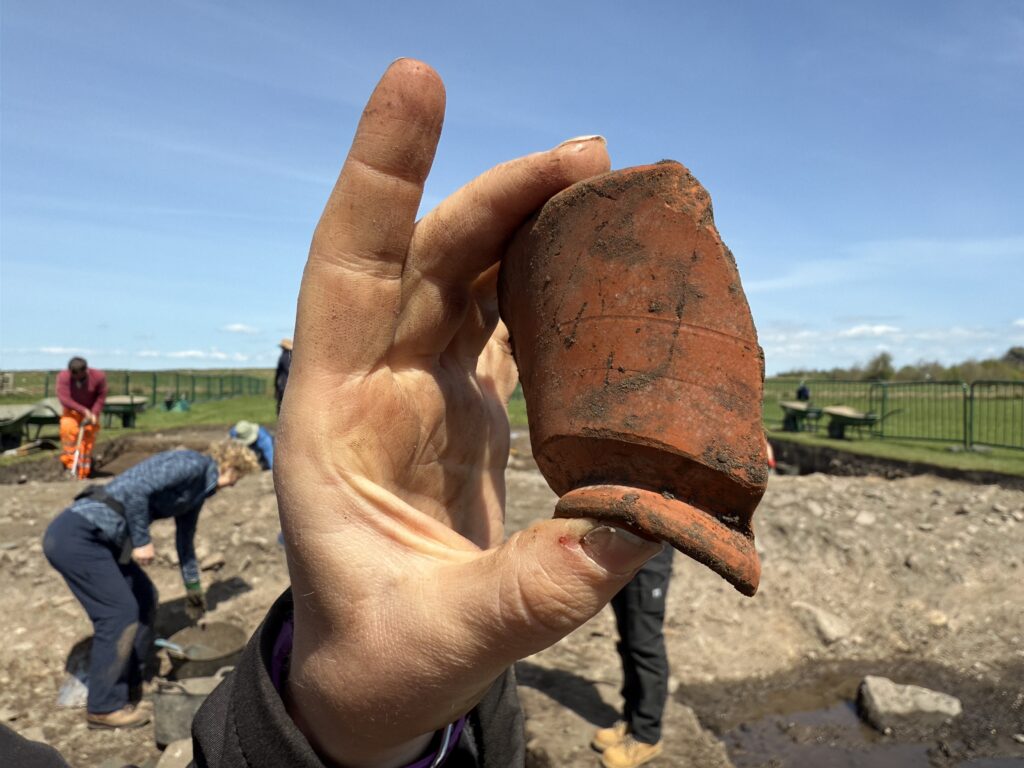
2nd May

Time really does fly when you’re having fun, as somehow we are already halfway through Period 2! The team have been making excellent progress in the trench, starting the week with some de-turfing to double the width of the excavation area. They have since been getting stuck into excavating the upper fills of the fort ditches and removing the collapsed rubble of the fort wall in this new section; with the work of Period 1 acting as a very useful guide.
The fort wall is still largely missing in action, it looks like the previous landowners and farmers have done a thorough job removing the stone for their own building projects. There are some mysterious areas of rubble close to the line of the wall which we need to investigate further, and it may be that the foundations are waiting for us down there.
As soon as we have reached the same contexts all across the trench we will be continuing down into the ditches where the promise of anaerobic deposits awaits. I can’t wait to see what we will learn about the ancient inhabitants of Magna fort through the material they’ve thrown away in the ditches and what surprises might be waiting for us. Rachel
28th April
Today we kicked off the start of our Period 2 excavation season with some fantastic new volunteers, and we couldn’t be more excited to have them join us in the trenches!
If you’ve been following our Dig Diaries from previous seasons, you’ll know that this isn’t just a place for the archaeological team to update you on our progress. It’s also a chance for our incredible volunteers to reflect on their experiences, whether they’re returning for their fiftieth season or joining us for their very first excavation with the Vindolanda Trust. Speaking of which, Graham, one of our Period 1 volunteers, has shared a beautiful poem that really captures the essence of his time here at Magna over the past two weeks… Sophie
Am empty plot with humps and bumps
Is this our field of dreams?
Just grab a spade, enjoy yourself
Our trusty Rachel beams.
So on we go, with trowel in hand
At last we have the weather
We move the stones, clean up the loose
But still no sign of treasure.
Day after day we toil and sweat
But wait, we hear a call.
Some ancient ring or pot perhaps
But no it’s just a WALL!
Deep in their ditch, they clean the fill
With none to share their troubles
For fellow friends are busy too
Up to their eyes in cobbles.
Is this a berm, we are confused
So Franki brings a barrow.
Just trowel away and soon you’ll see
Berm today and gone tomorrow!
A plan is hatched to end our woes
We’ll make the trench quite tidy
And then when no one’s watching us
We’ll run away on Friday.
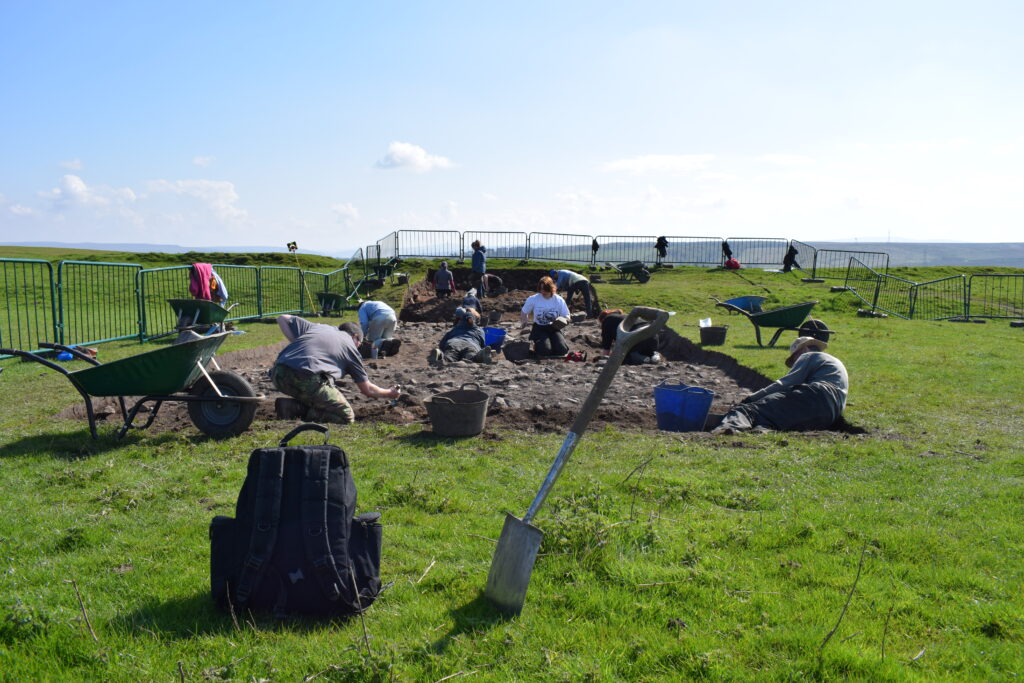
25th April
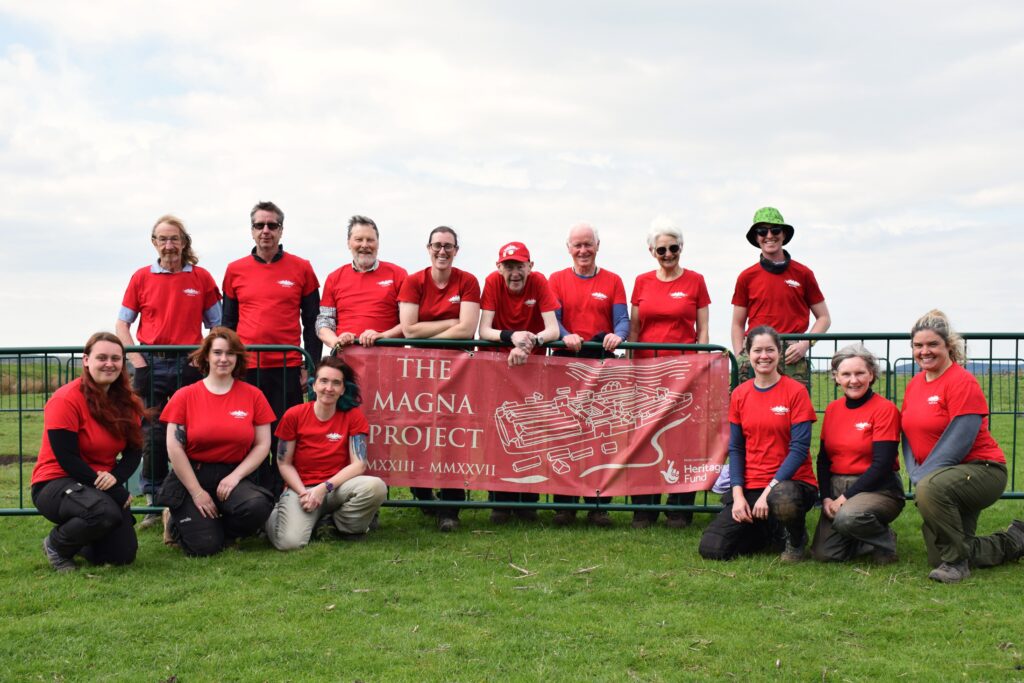
Meet our amazing Period 1 volunteer crew who’ve officially launched Year 3 of the Magna Project with buckets of energy (and quite a bit of mud!) They have been hard at work over the past two weeks, as we have moved into our new excavation area for 2025 at the northern fort walls and defensive ditches here at Magna. A huge thank you to our Period 1 team for getting the season off to a fantastic start! We can’t wait to welcome our Period 2 volunteers on Monday.
As regular readers of our Dig Diary will know, our updates often include a mix of excavation highlights and reflections on the famously changeable Northumbrian weather. But, there is a reason for all our weather chat – it ties into our broader research on how climate change is affecting buried archaeology.
Interested in learning more? Join us for a one-day conference at the Roman Army Museum and Magna Fort, where we’ll be exploring the theme of climate change and its impact on archaeology. From the unique conditions at Magna Roman Fort to the broader frontier landscape of Hadrian’s Wall, it will be a fascinating day of discussion and discovery.
Tickets are available for both in-person and online attendance – book yours here! Sophie
22nd April
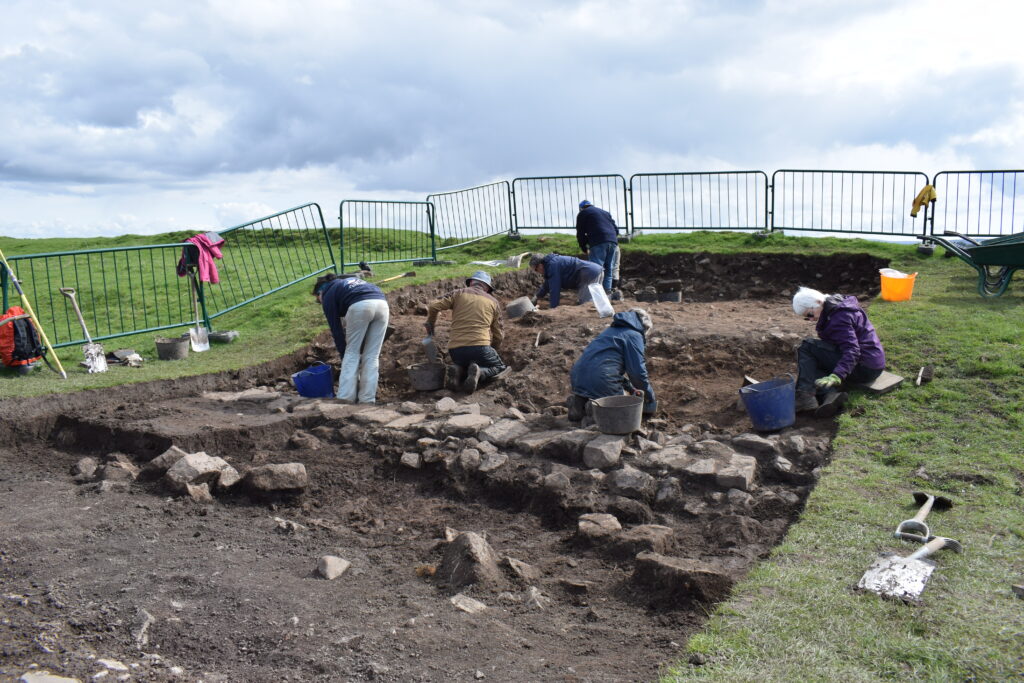
Another sunny excavation day at Magna, and we are already seeing some interesting features within our excavation area. Up near the fort wall, we’re chasing a potential robber trench where resourceful individuals might have taken the well-made Roman facing stones to help construct their own buildings (maybe even bits of Carvoran farm). Luckily, they left behind plenty of Roman pottery and animal bones for us to find in their wake. Additionally, it seems like the upper layer of our first fort ditch contains some of these facing stones which were likely pulled into the ditch by ploughing at some point in time. We’re keen to record and then remove these stones to see if they might have any inscriptions or graffiti on them. Unfortunately, it looks like we won’t have any facing stones from the most recent stone fort left in situ – but there is still hope for the earlier forts beneath the ‘visible’ one.
Moreover, we got our first taste of waterlogged soil today, which means the anaerobic is not far off. This year we should have anaerobic deposits within all fort ditches in our excavation area, which means that there is large potential for organic material artifacts like leather shoes and wooden objects. This group of volunteers have moved a lot of dirt to get us to where we are now, and I am keen to see what else they can uncover in their final three days of excavation! Franki
18th April
We have reached the end of our first week of excavation and already we have made a lot of progress, even if some wet weather tried to slow us down on Wednesday. We can now see two of the defensive ditches that were dug to the north of Magna fort, along with areas of cobbling laid in the spaces between them. The surface at the north end of the trench is much flatter and made of smaller cobbles than the one between the first and second ditch, suggesting this could be a road running around the outside of the fort.

At the other end of the trench, we are also on a mission to find the fort wall. Currently this area is covered by a deep layer of rubble created by the collapse of the Roman fort wall and more recent dry stone field wall, meaning there are a lot of rocks to shift. However, this should have protected the underlying archaeology from later damage so there should be some intact Roman features waiting as our reward!
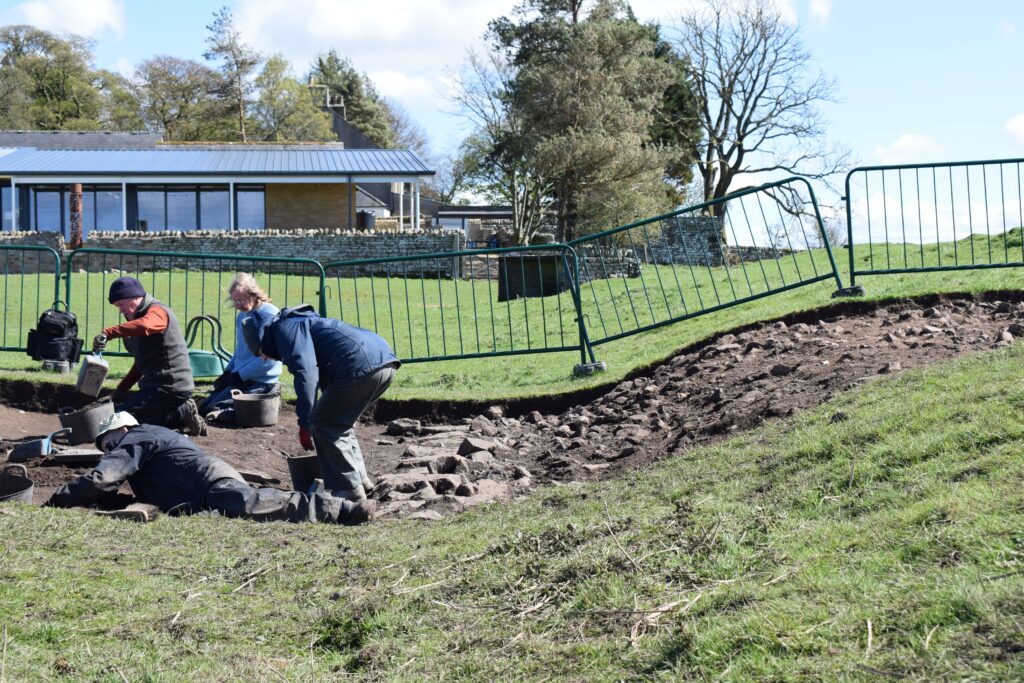
We are still finding a variety of Roman pottery and have had a few animal bones starting to come up, things I’m sure we’ll find a lot more of in the coming weeks as we start going down inside the ditches to see what the Romans have thrown into them over the centuries. Rachel
15th April
We have officially broke ground on the 2025 Magna excavation season! Our Period 1 volunteers arrived yesterday to cold but dry weather, and they began stripping off the turf in the afternoon. Unlike the past two excavation seasons, where we were able to use a mini 360 excavator to get rid of the grass, we must de-turf by hand this year because the archaeology is so close to the surface. We’re beginning our excavations near the north stone wall of the latest rendition of Magna fort and then continuing north across the fort rampart and ditches. The first ditch is very prominent in the landscape, although it does, unfortunately, have a Victorian stone field drain cutting through it. Nevertheless, we’re confident that the deposits underneath this stone drain are relatively untouched.
Already, we’ve found nice sherds of black burnished ware, mortaria, and even a bit of Samian.
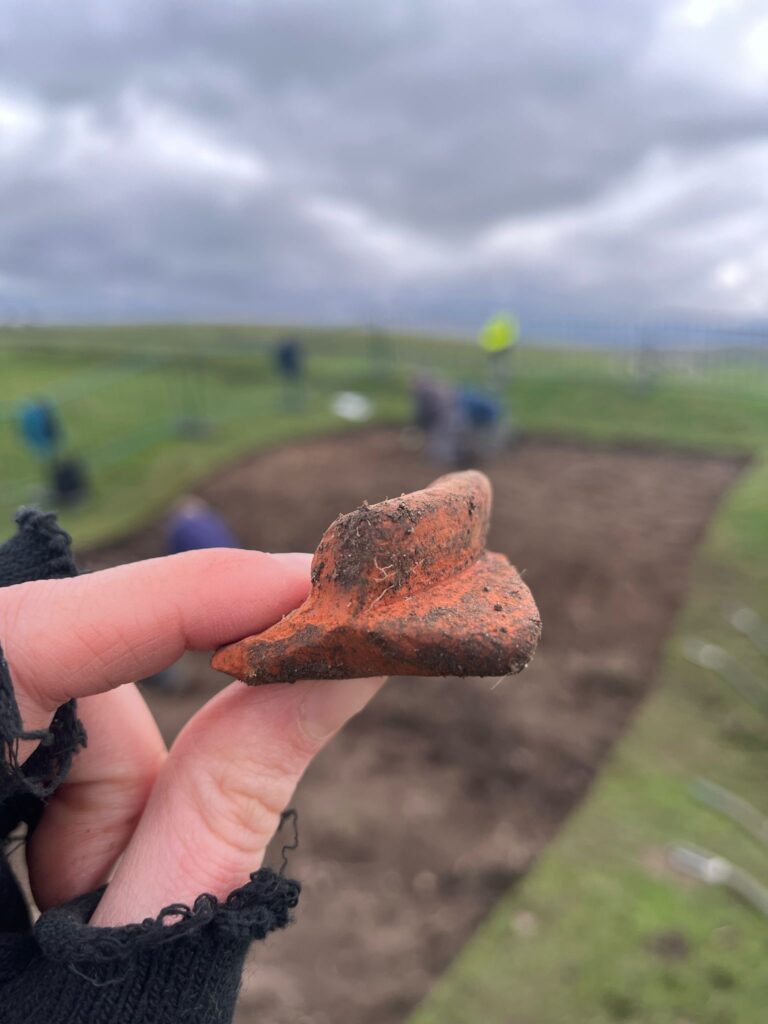
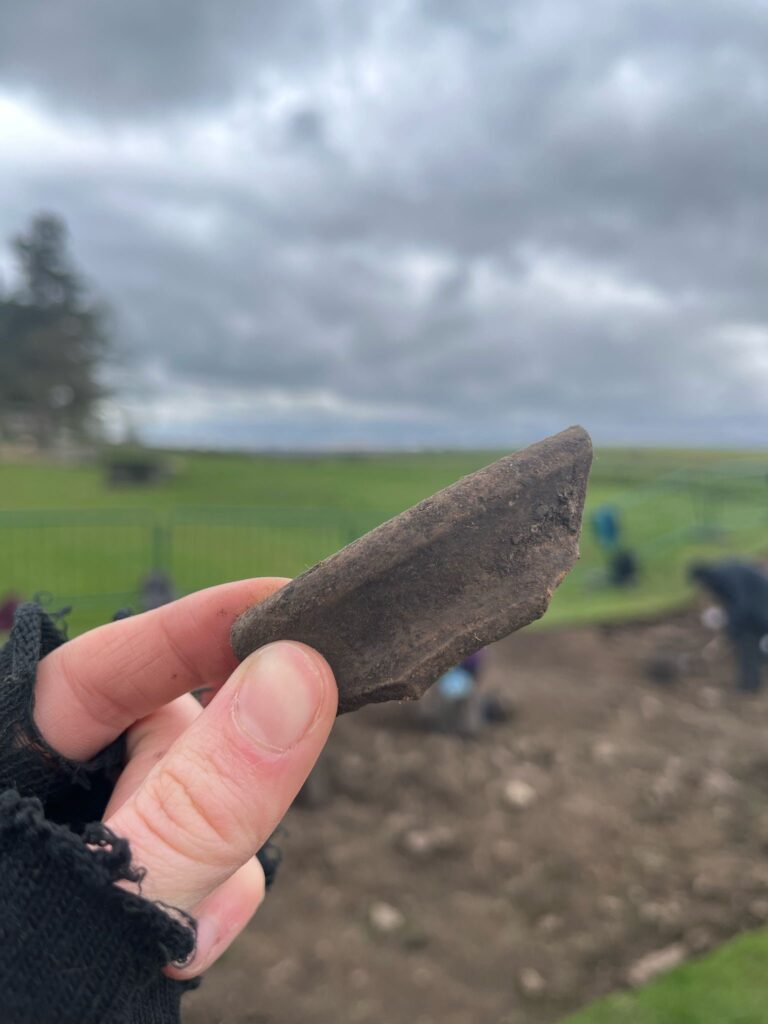
This bodes well for us as we continue to get rid of the previously plowed topsoil, and into the secure Roman contexts. With less than two full days under our belts right now, I think we’re making great headway into an exciting summer! Franki
13th April 2025
In exciting news – soil sampling for the 2025 season has begun! Last week, Rebecca (archaeology assistant for the Trust) and myself took a series of topsoil samples for elemental analysis. These samples will be processed with a pXRF (portable X-Ray Fluorescence) machine and could potentially give hints as to where important archaeological features are located. As we begin uncovering different layers of occupation within our trench, we will take more soil samples like these so as to build a comprehensive survey of the elemental makeup of the soil across the ditches. Franki
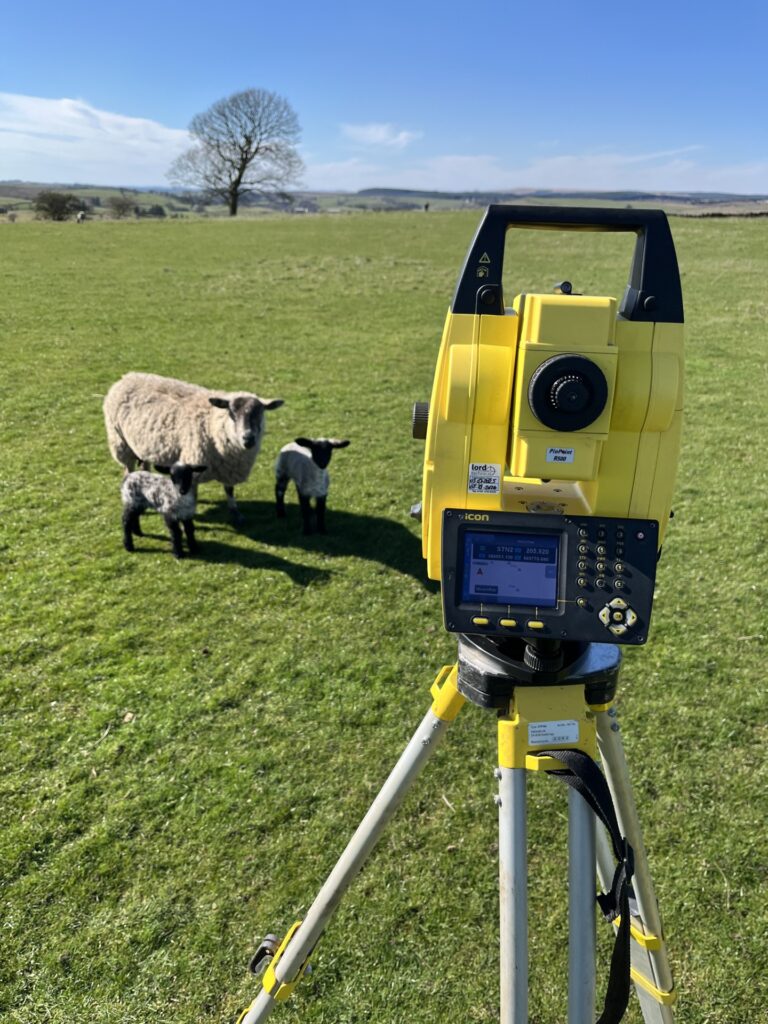
11th April 2025
You may have heard the exciting news that excavations have officially started at our sister site of Vindolanda this week, which means there’s only a few days left until we will be back out in the trenches at Magna!
If you’ve visited the site recently for a sneak peek at where we’re digging, you might have spotted some of our field’s newest residents out exploring the excavation area. Don’t worry though, we haven’t seen any armed with trowels or bags of finds to show off to their friends!
We are busy doing the final preparations on and off site, making sure the spades are polished, and the biscuit barrel is stocked. We can’t wait to meet our first group of volunteers on Monday to get stuck into a new excavation area; and of course share our discoveries here in the dig diary. Rachel
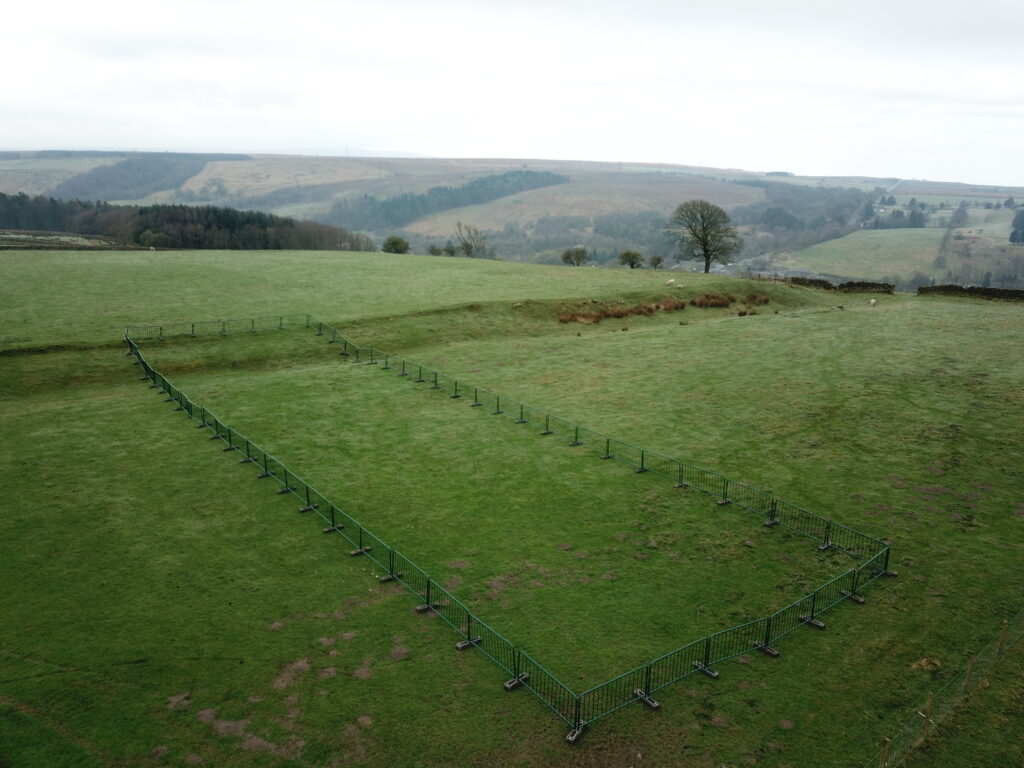
1st April 2025
Spring has slowly but surely started to arrive in Northumberland and that means only one thing here at Magna: its nearly time to start excavating!
This year we will be moving into the fort field, opposite the new activity and archaeology centre, with a long trench stretching out from the north edge of the fort platform. Although it may look like an unassuming area of flat grass today, in the Roman period it would have been dominated by the northern ditches and ramparts of the last stone fort. There could be up to five of these waiting to be excavated, and potentially other archaeological features dating to different phases of the fort’s history. As with so much of the site, the ground here is frequently waterlogged and early trials in the 1970s showed that the anaerobic conditions needed to preserve organic material existed below the turf. This means there could be all sorts of exciting surprises preserved within the ditch fills, especially as the Romans often used the fort ditches as rubbish dumps!
The fences are up, the wheelbarrow fleet is assembled, and we can’t wait to welcome our first team of volunteers to get stuck in uncovering more of the history of Magna. All that’s left to do now is pray for some nice weather! Rachel
